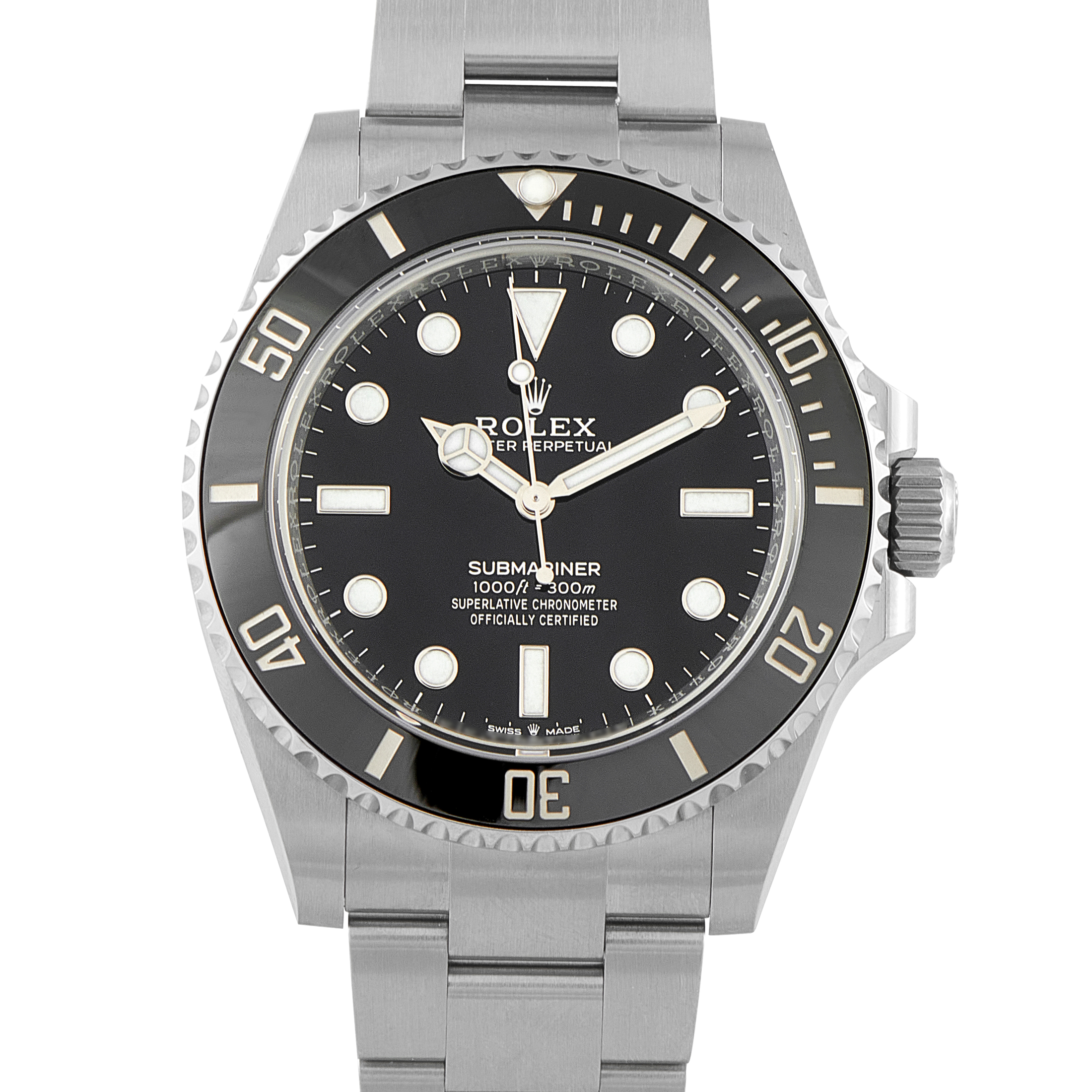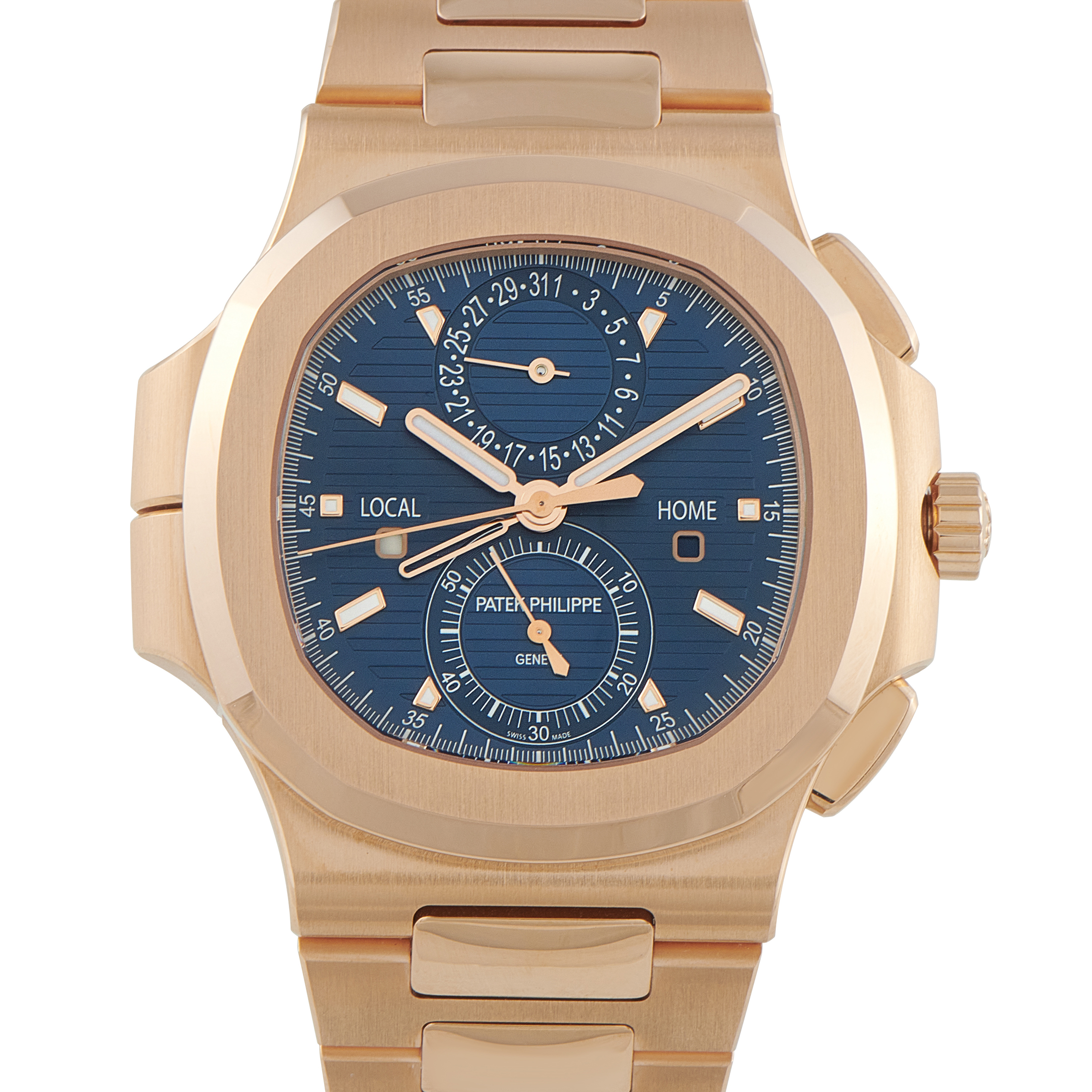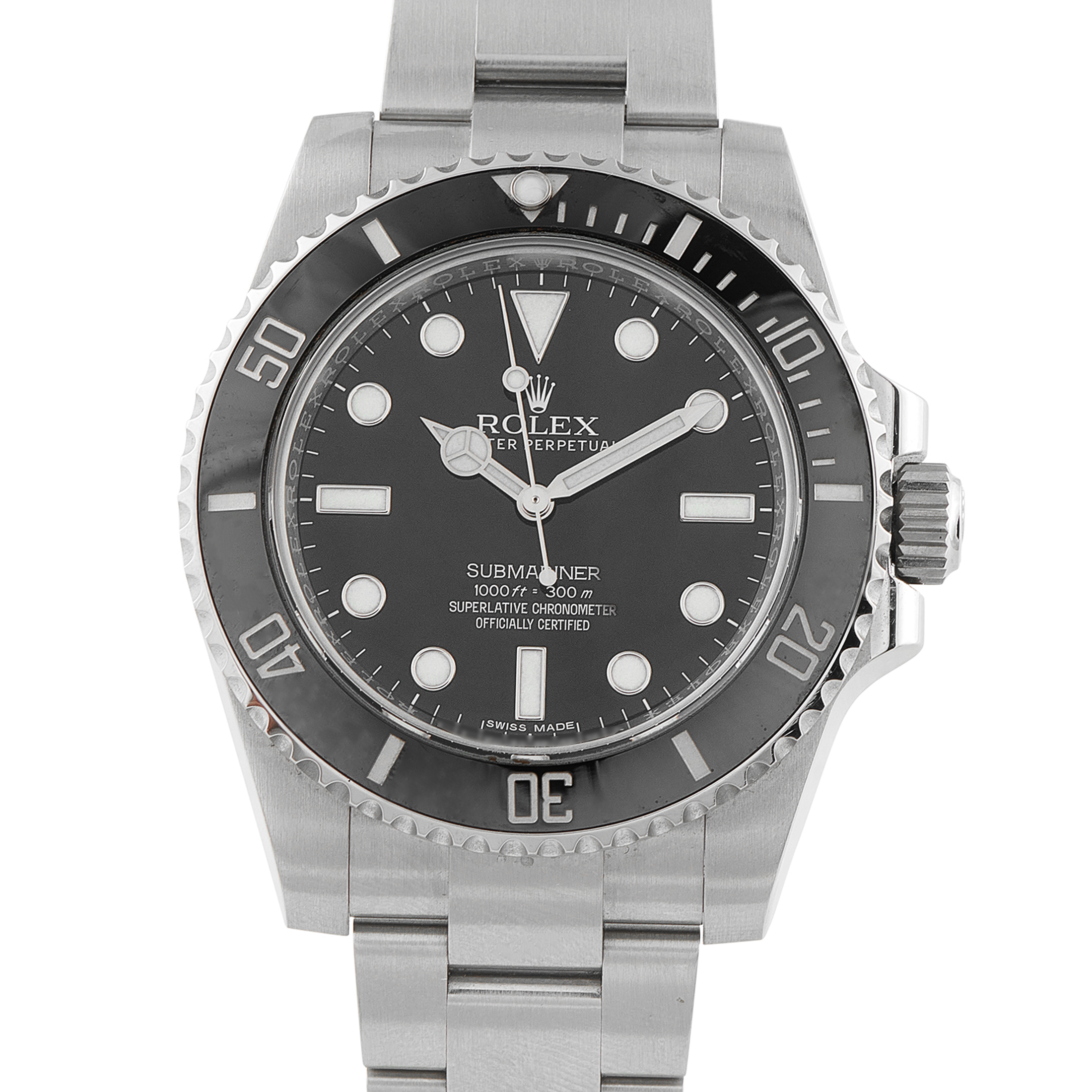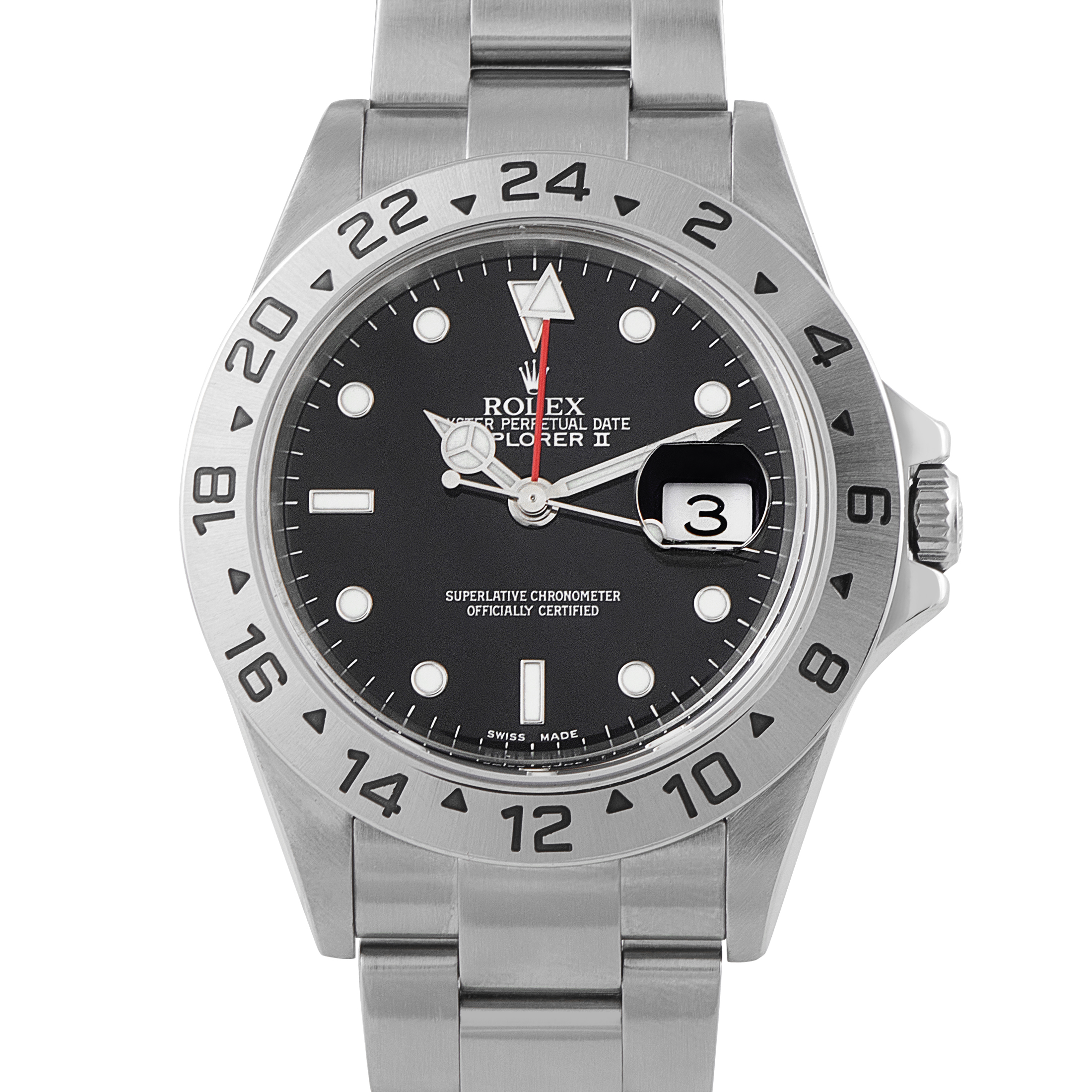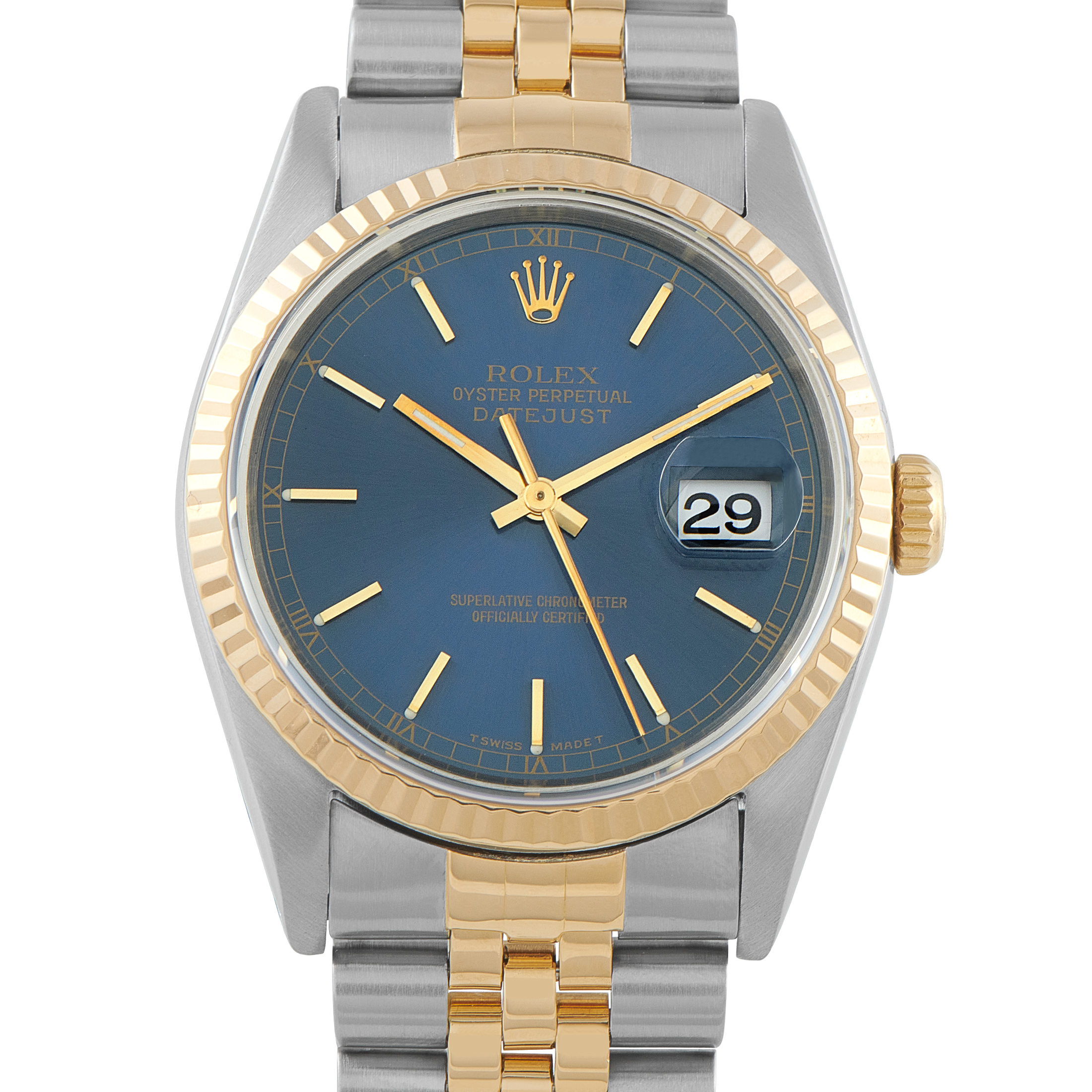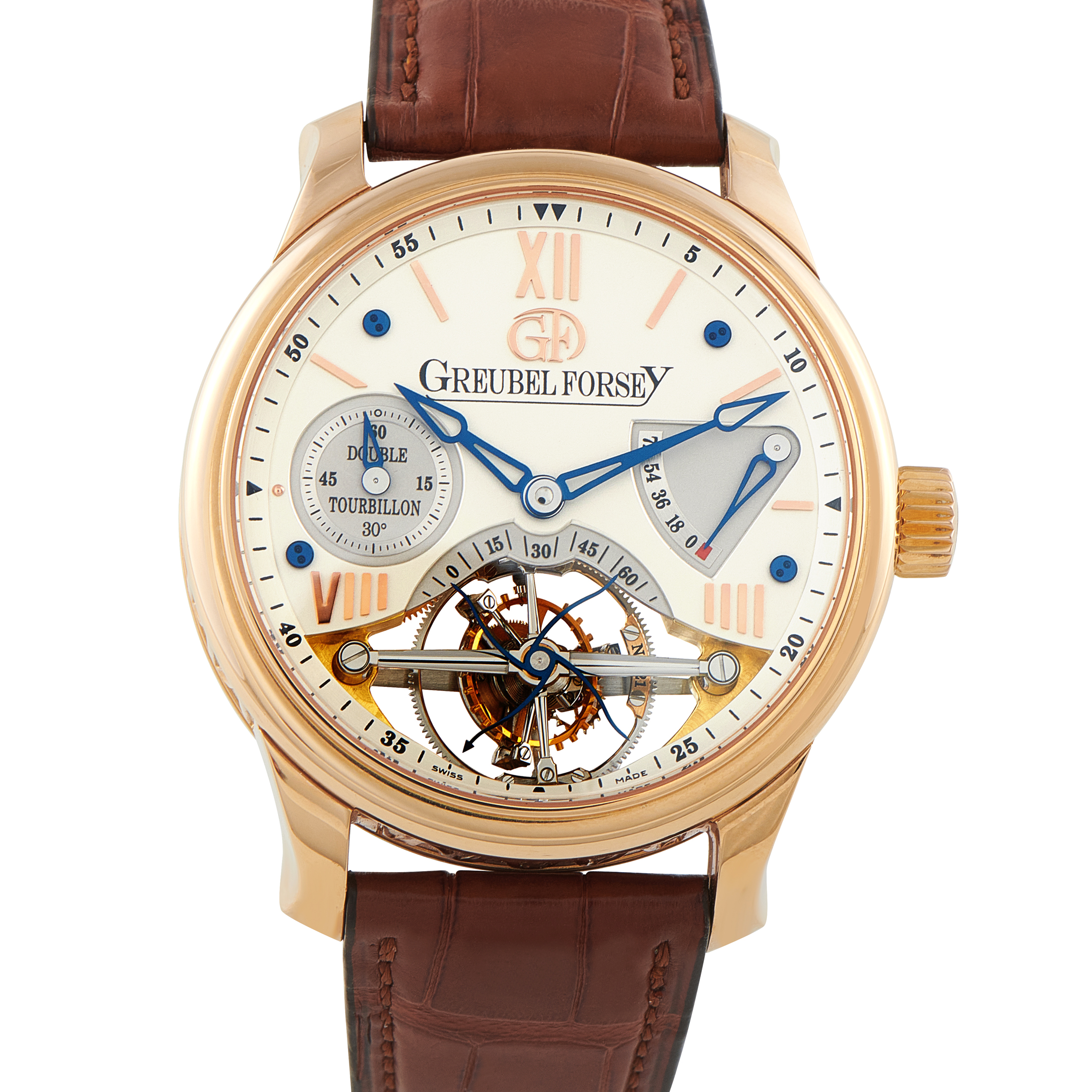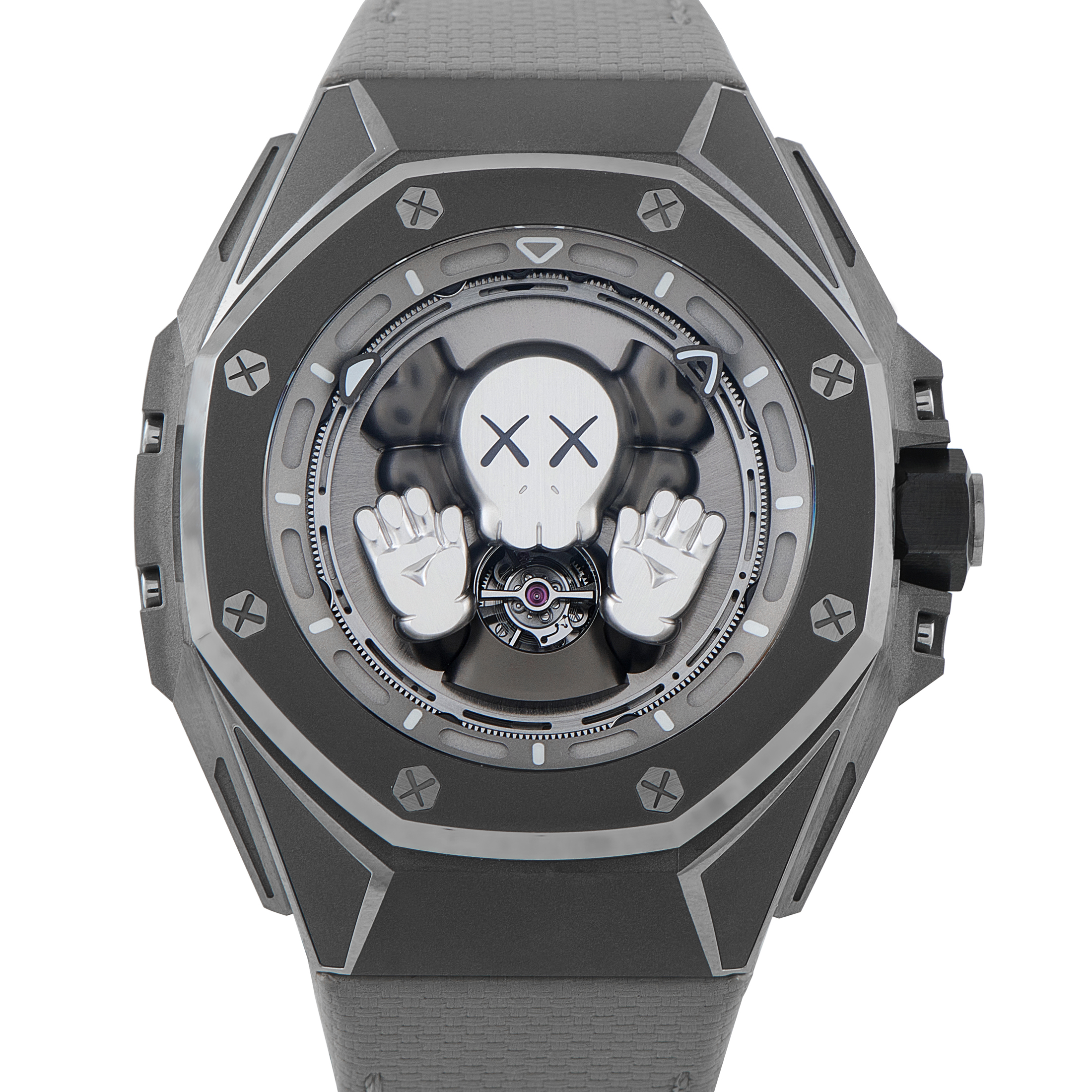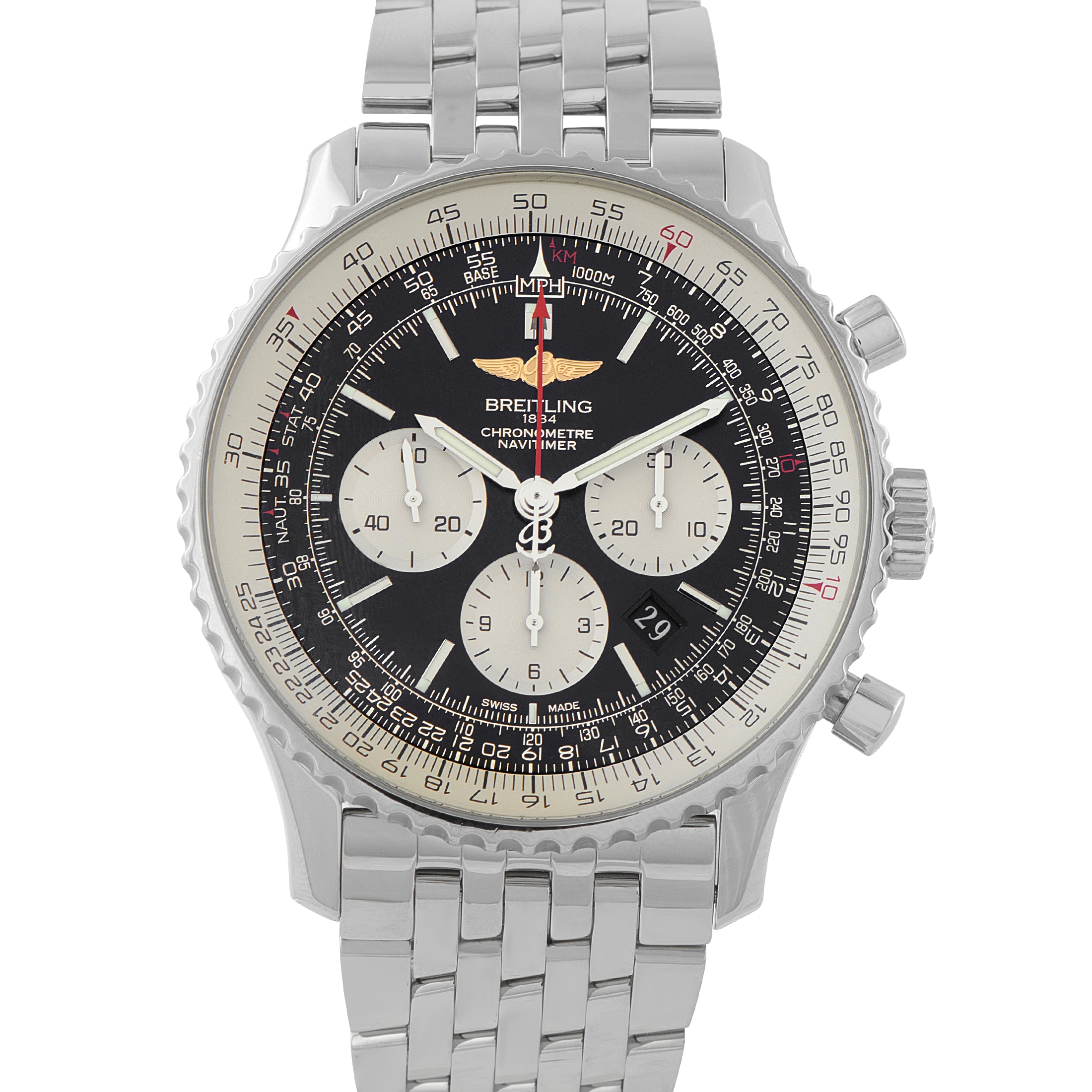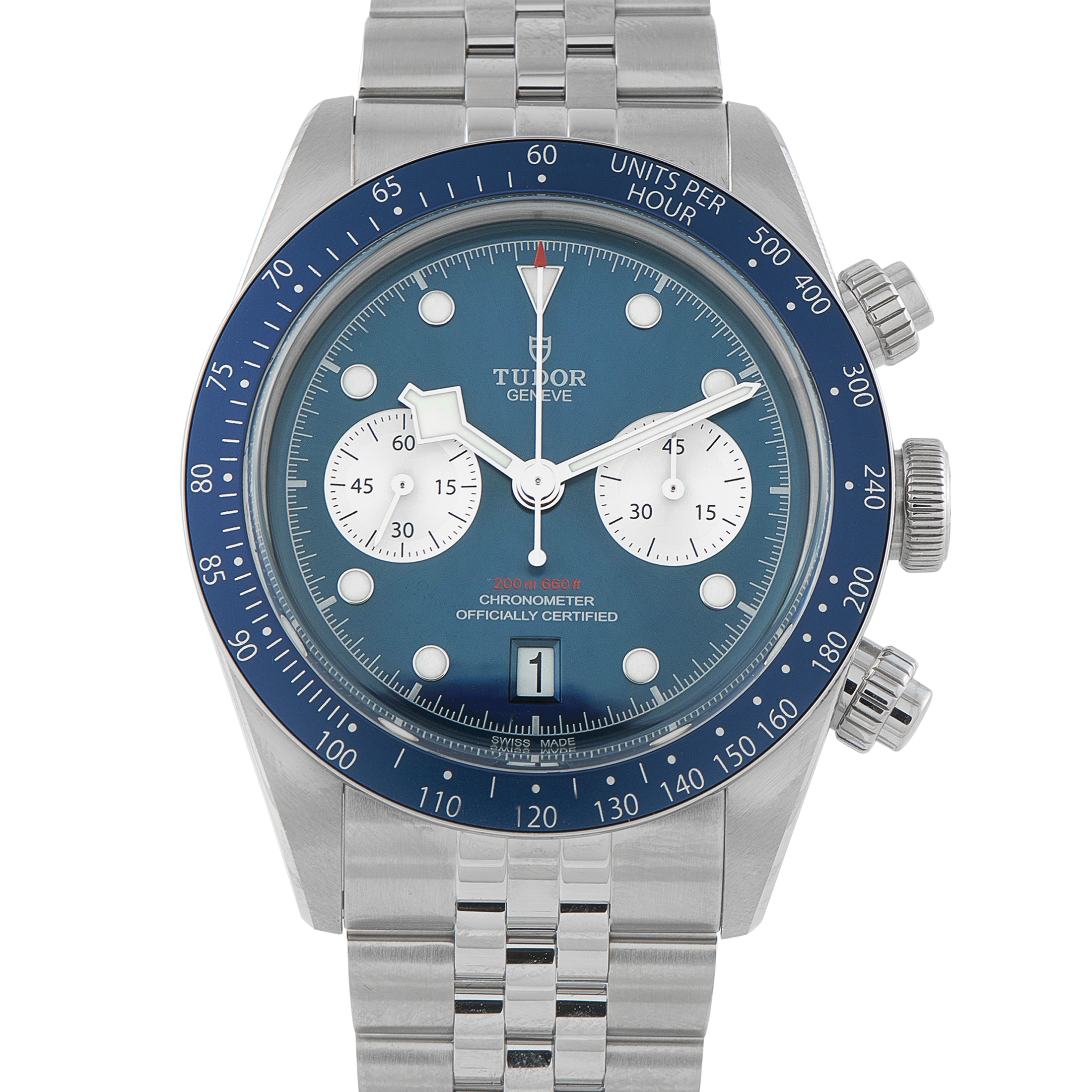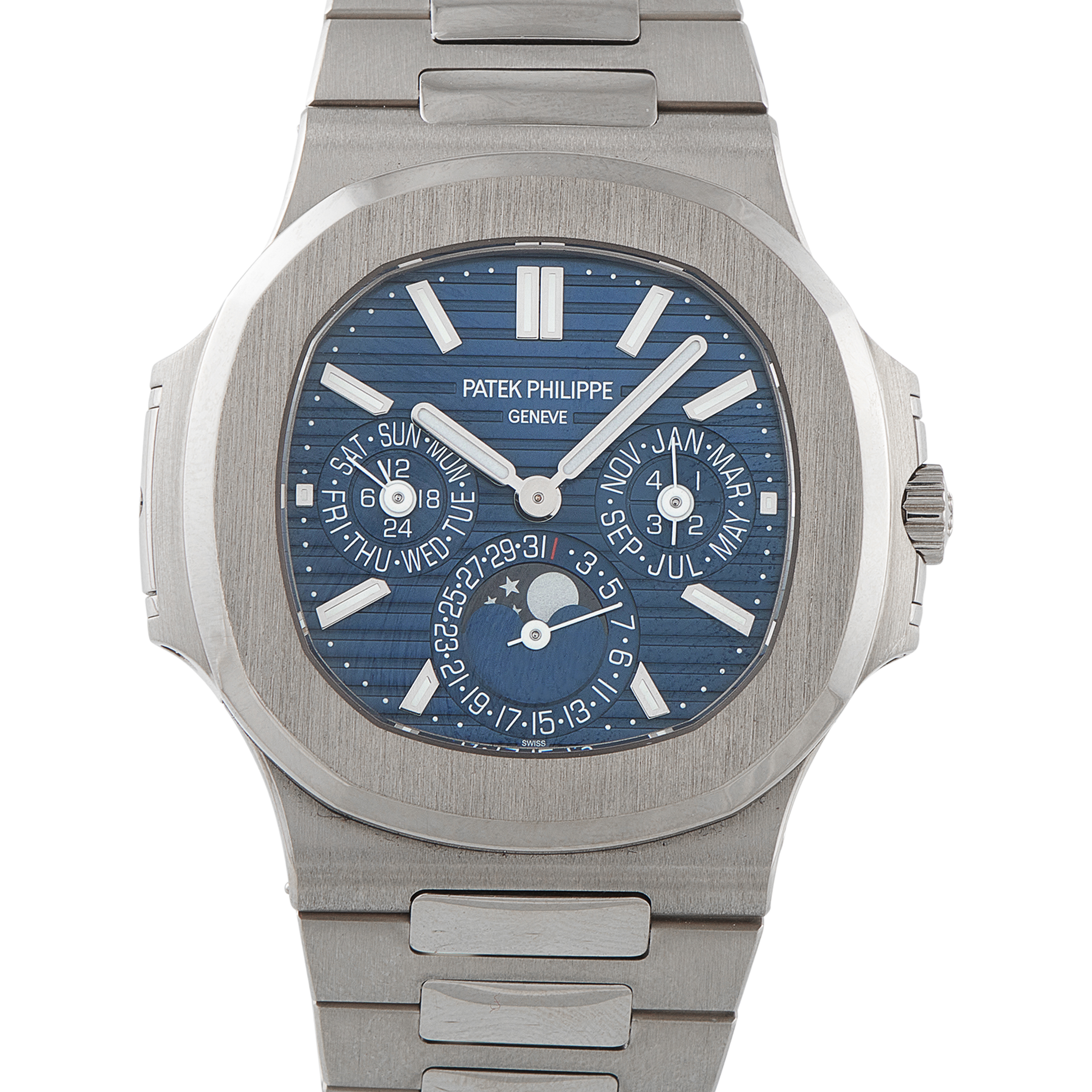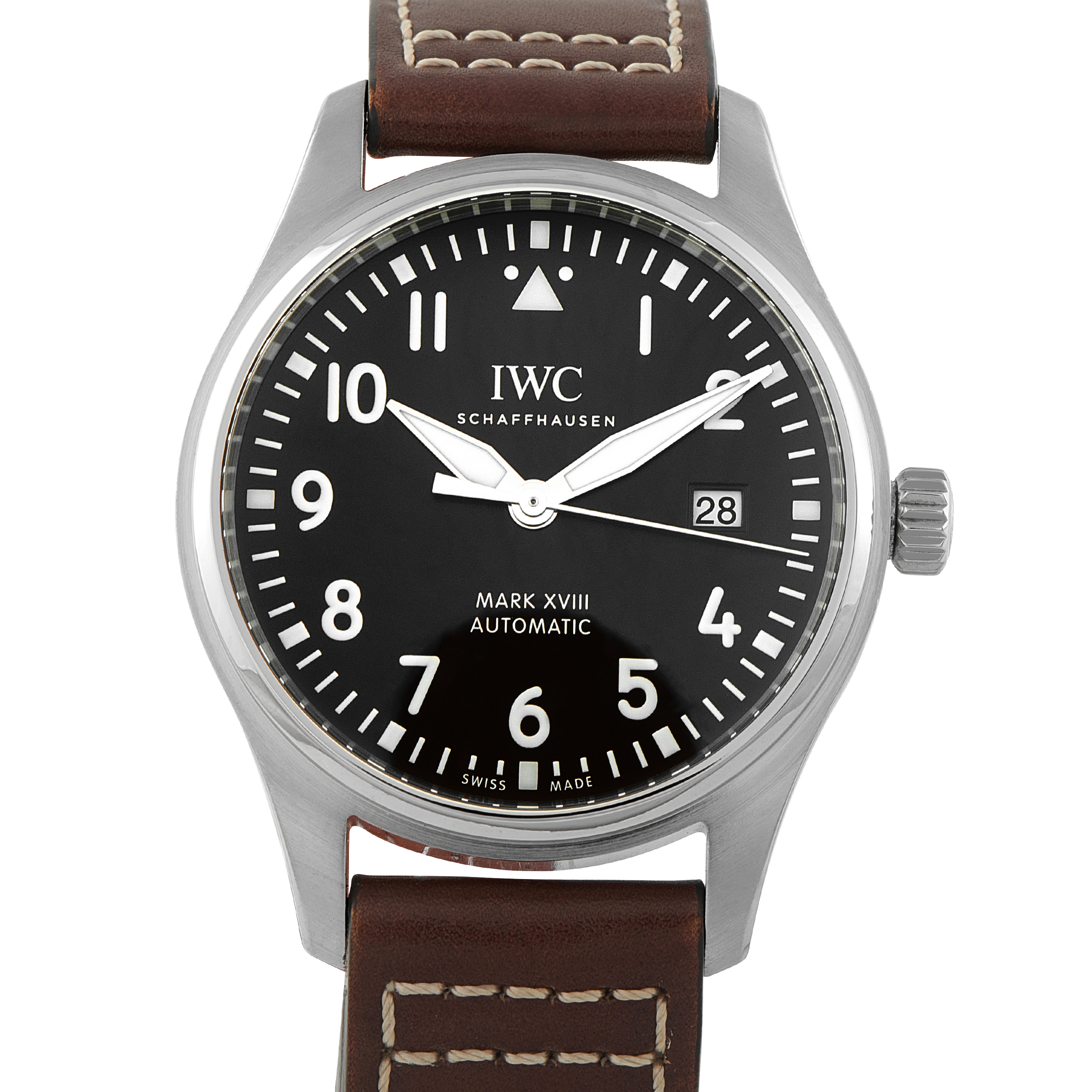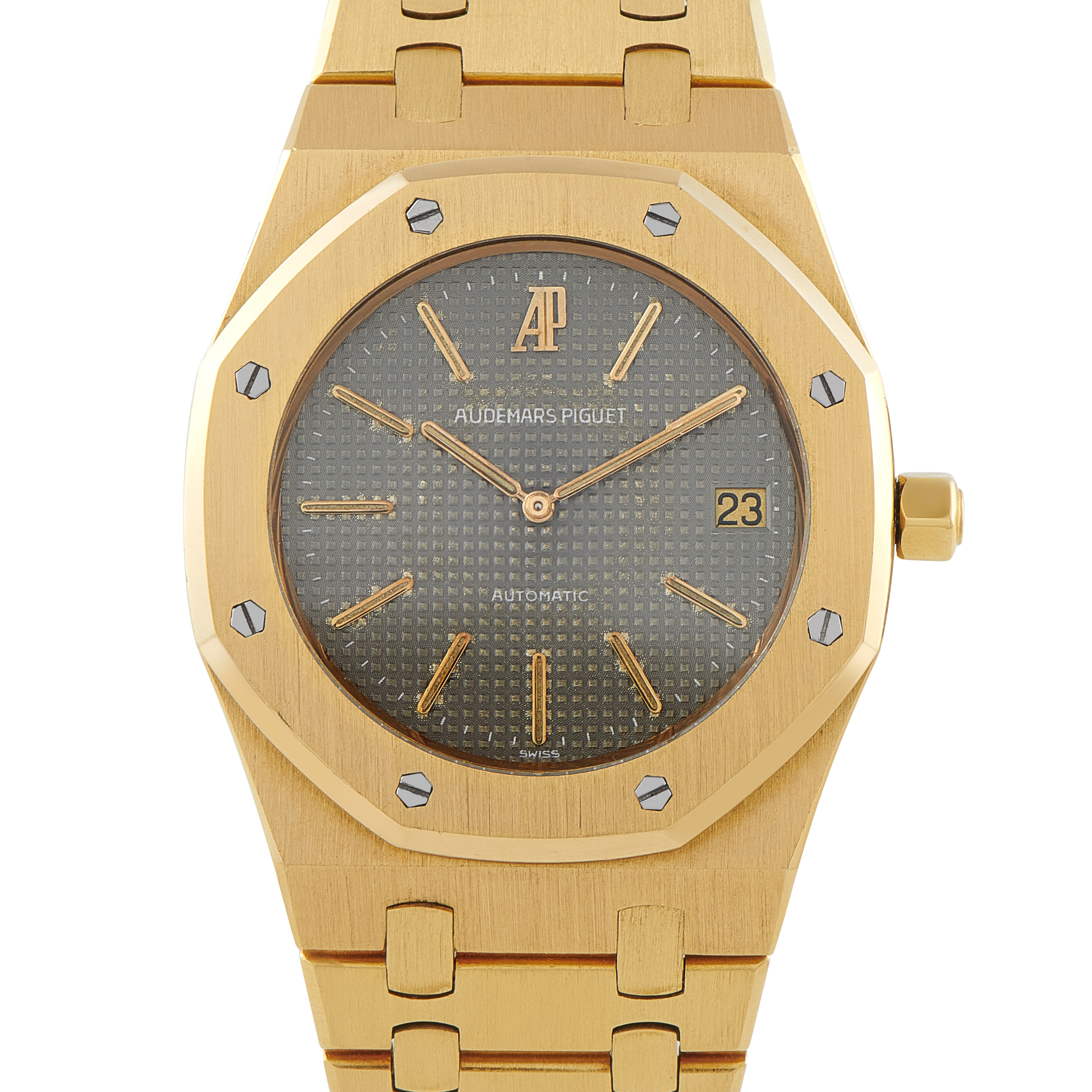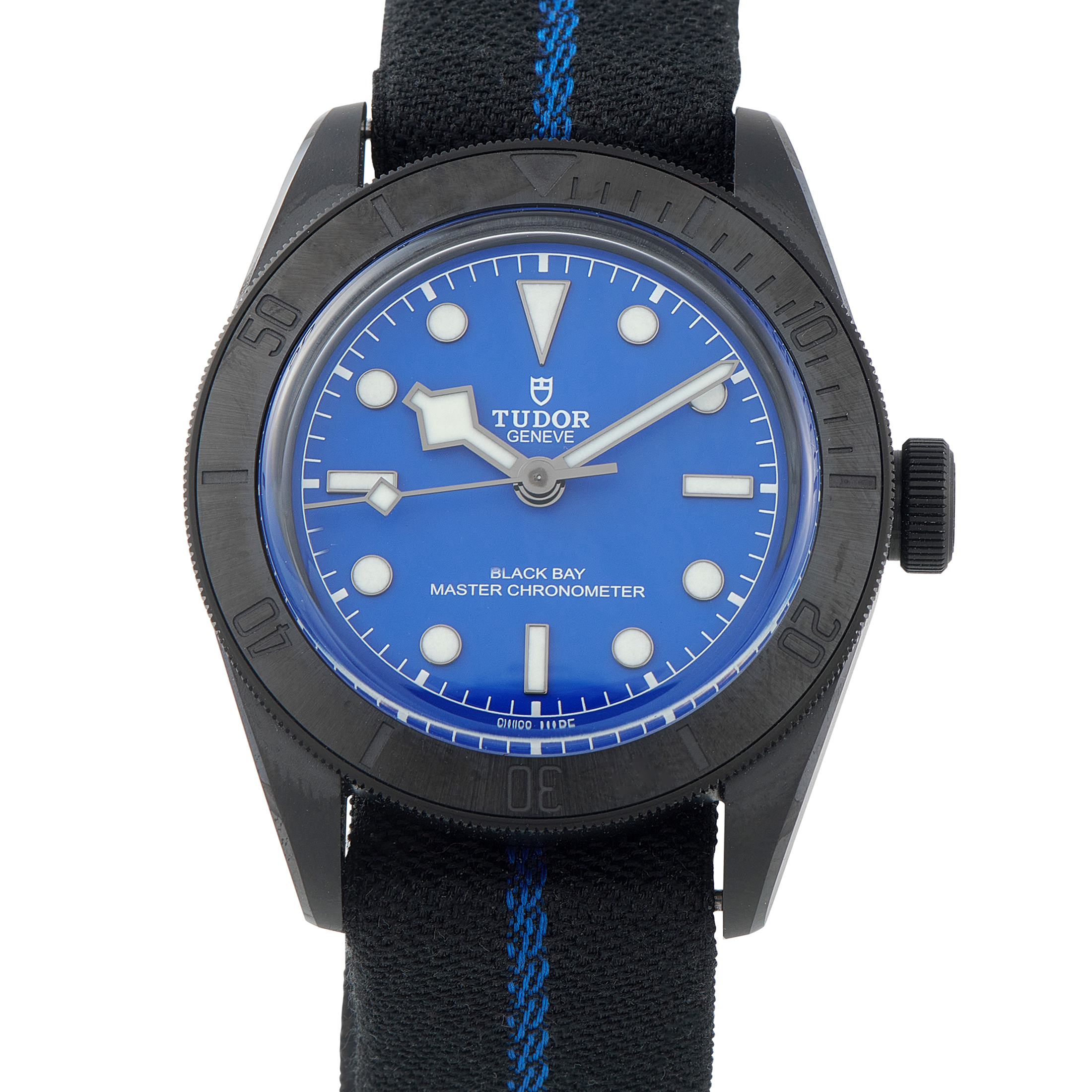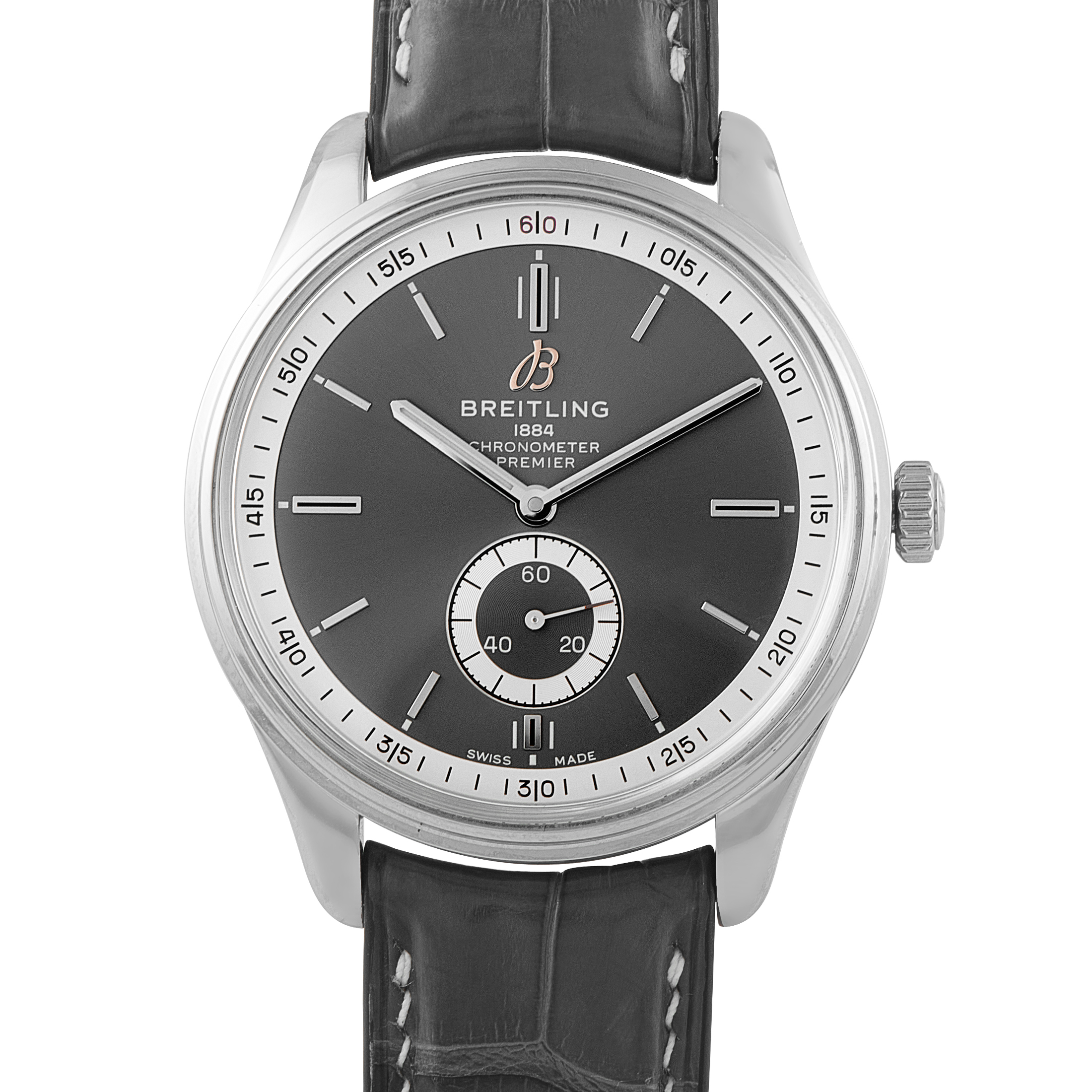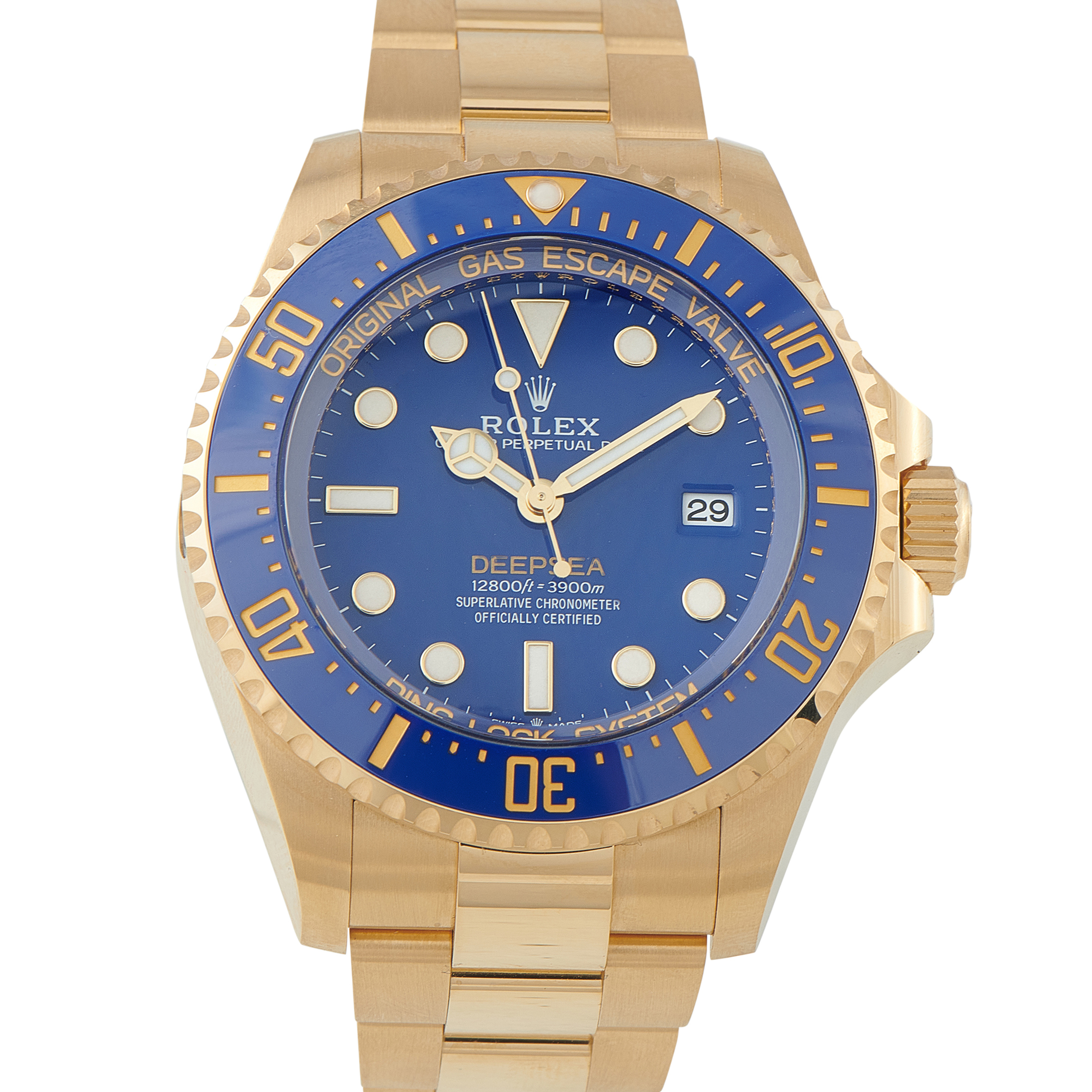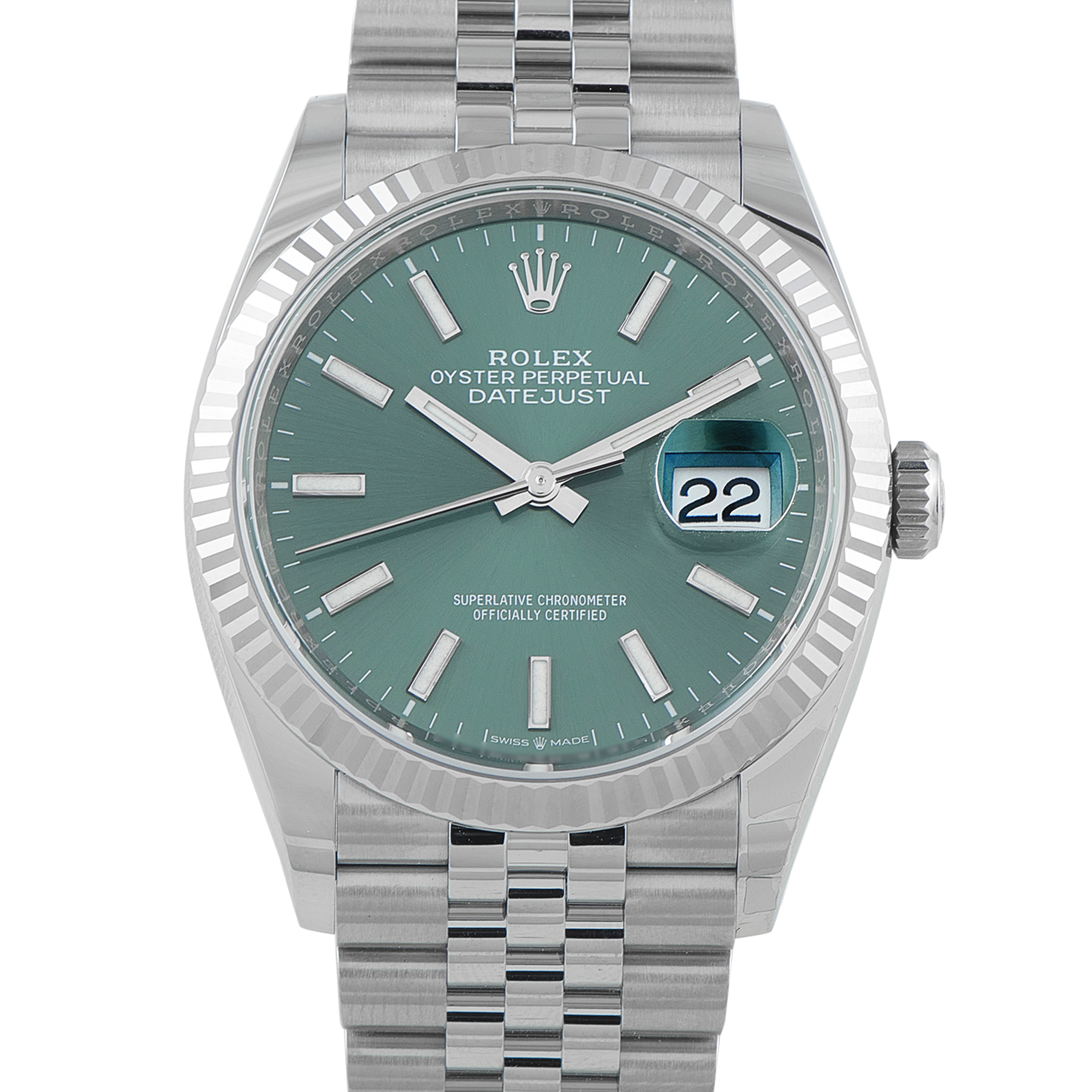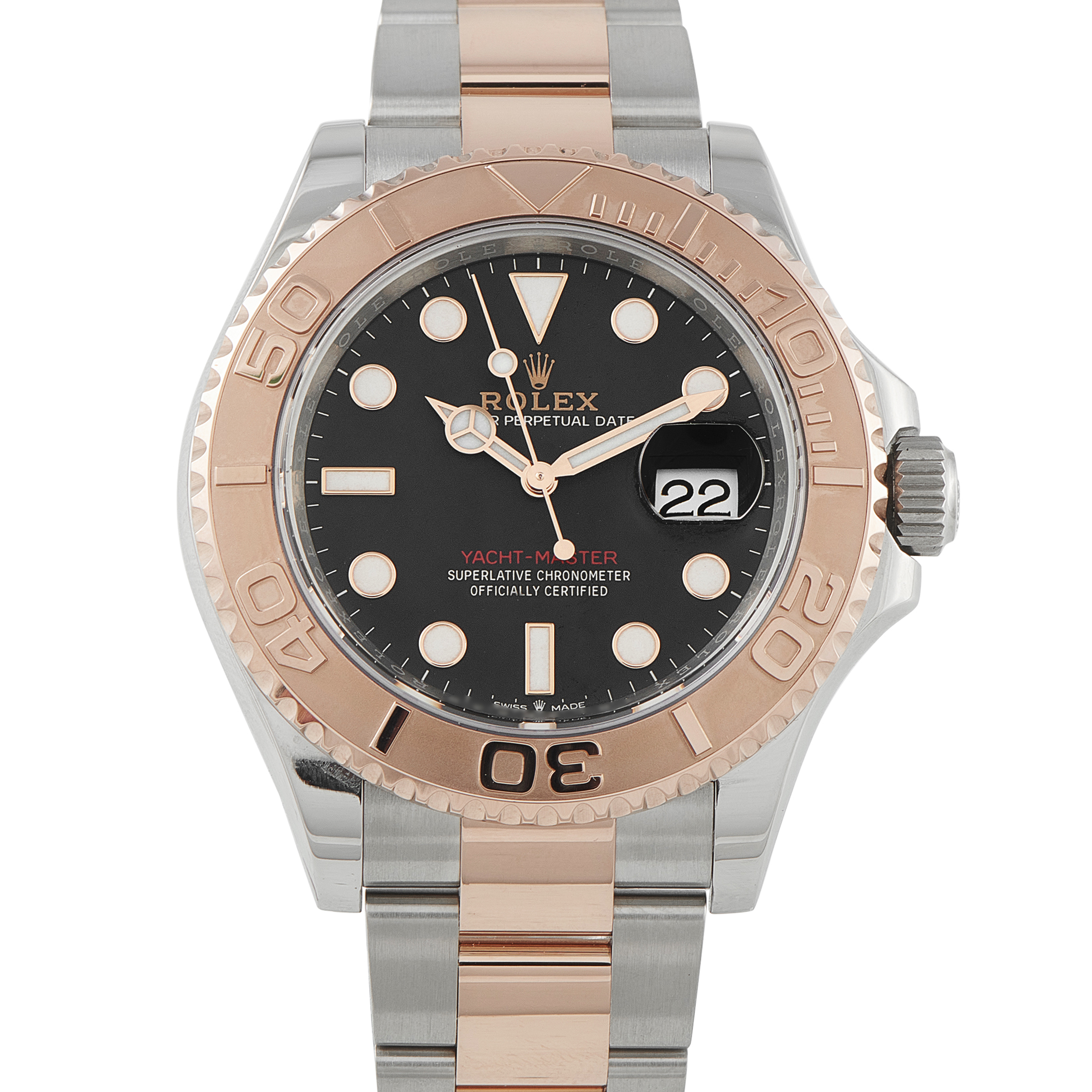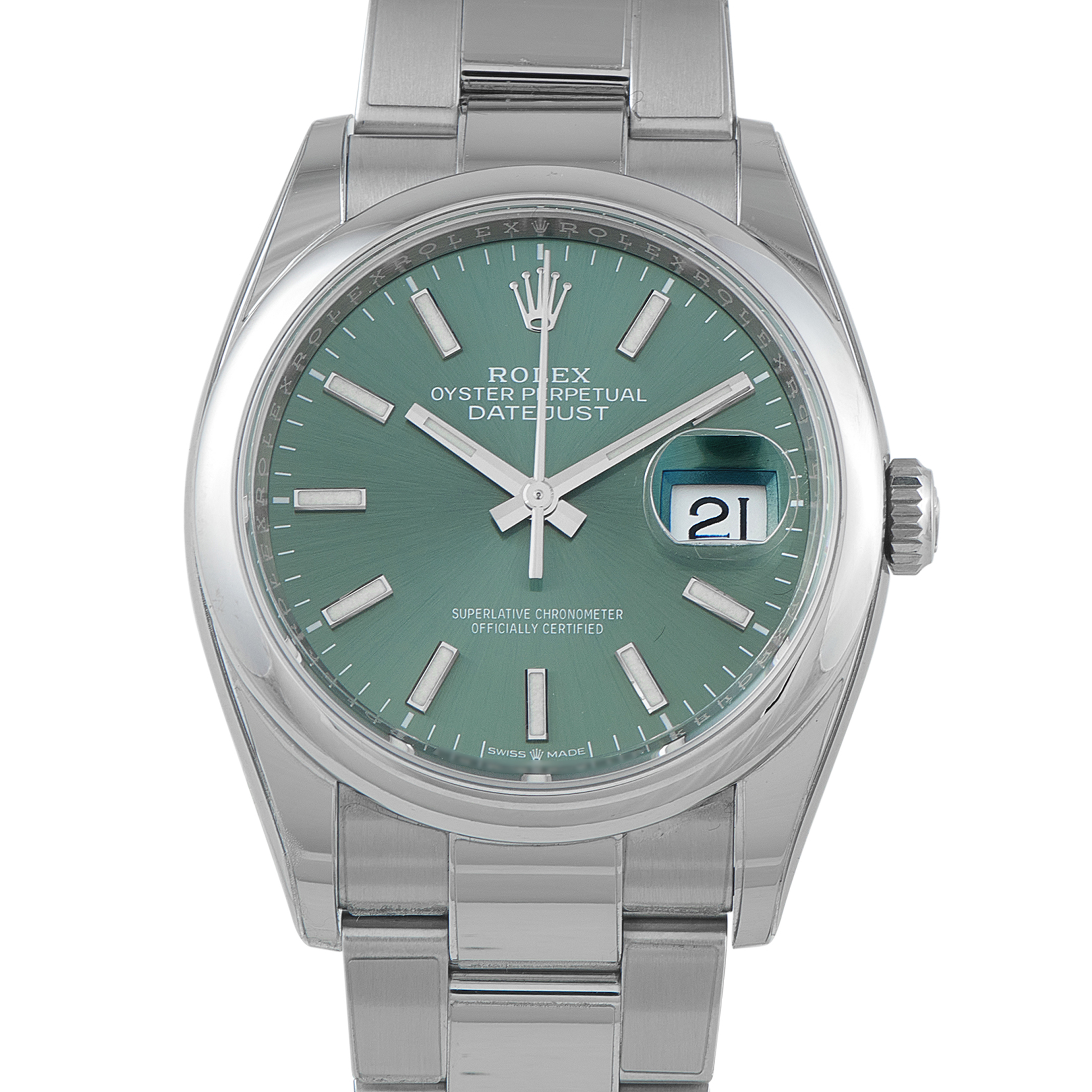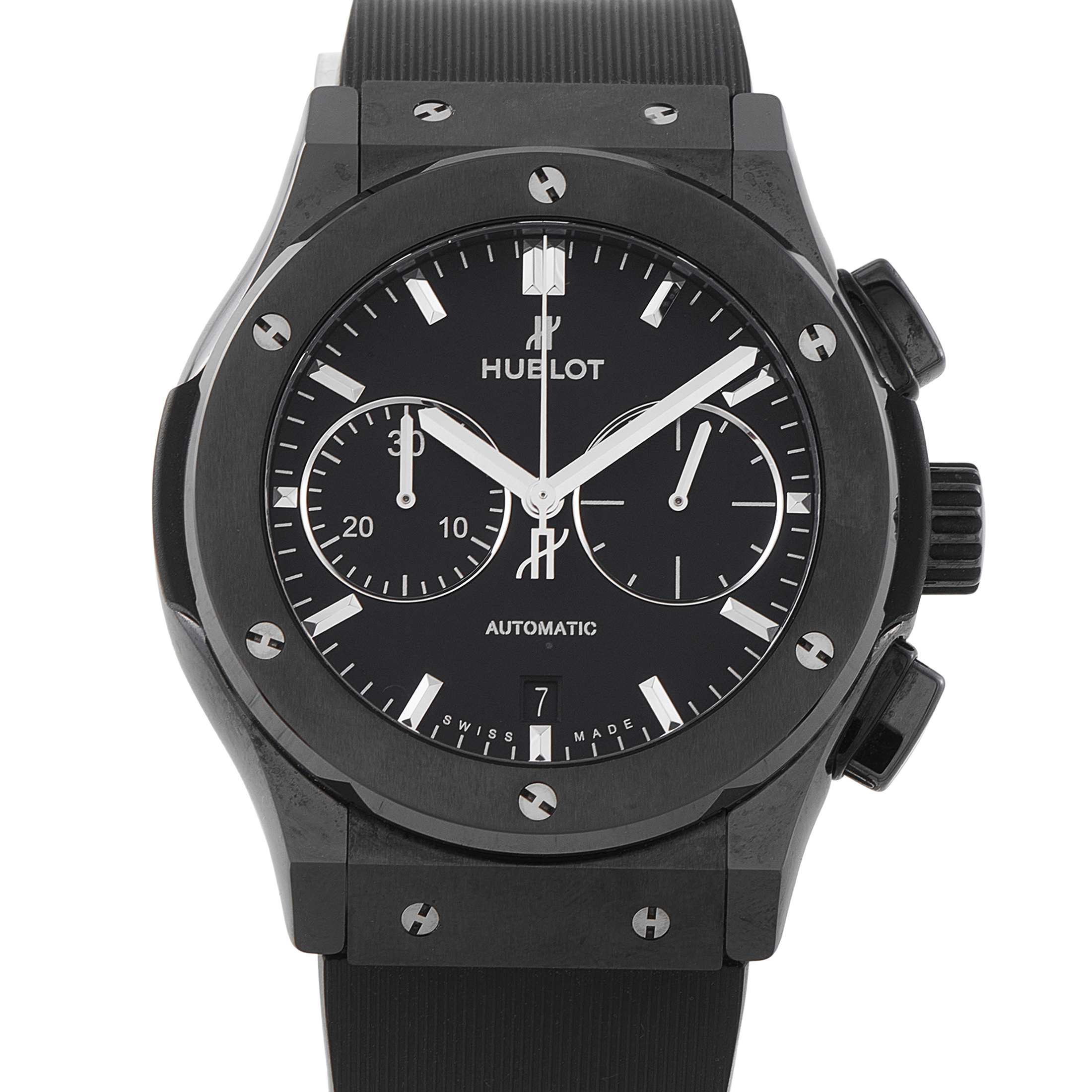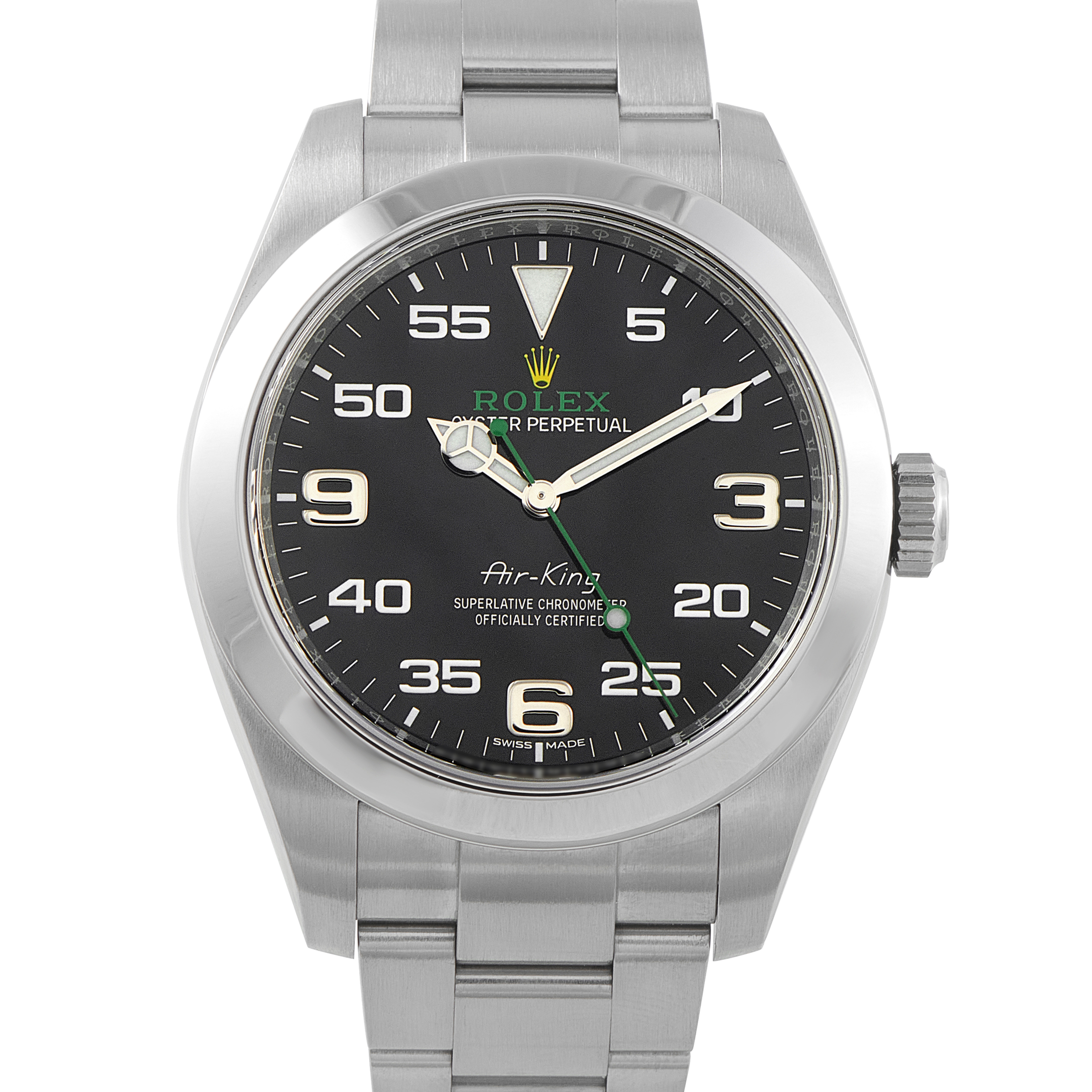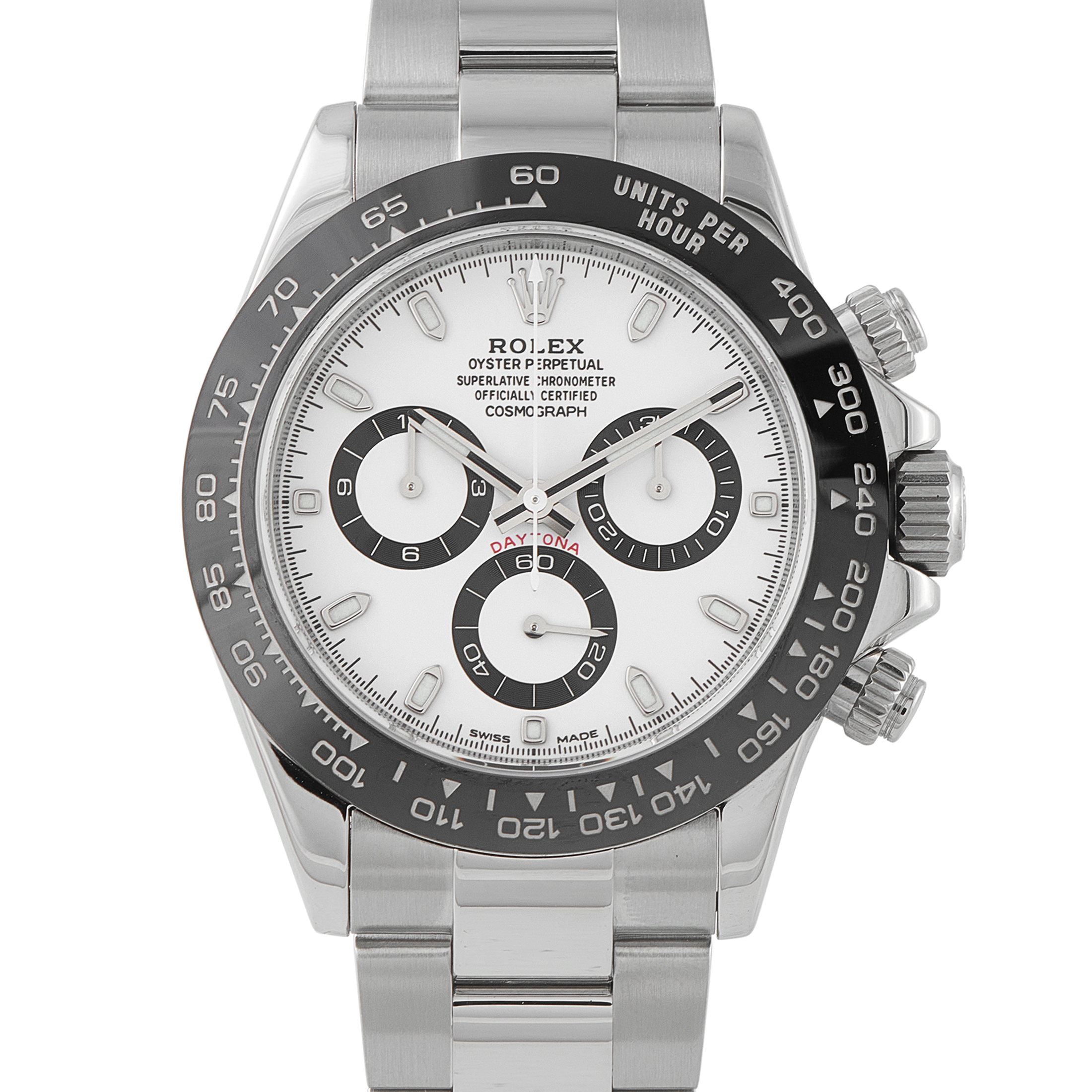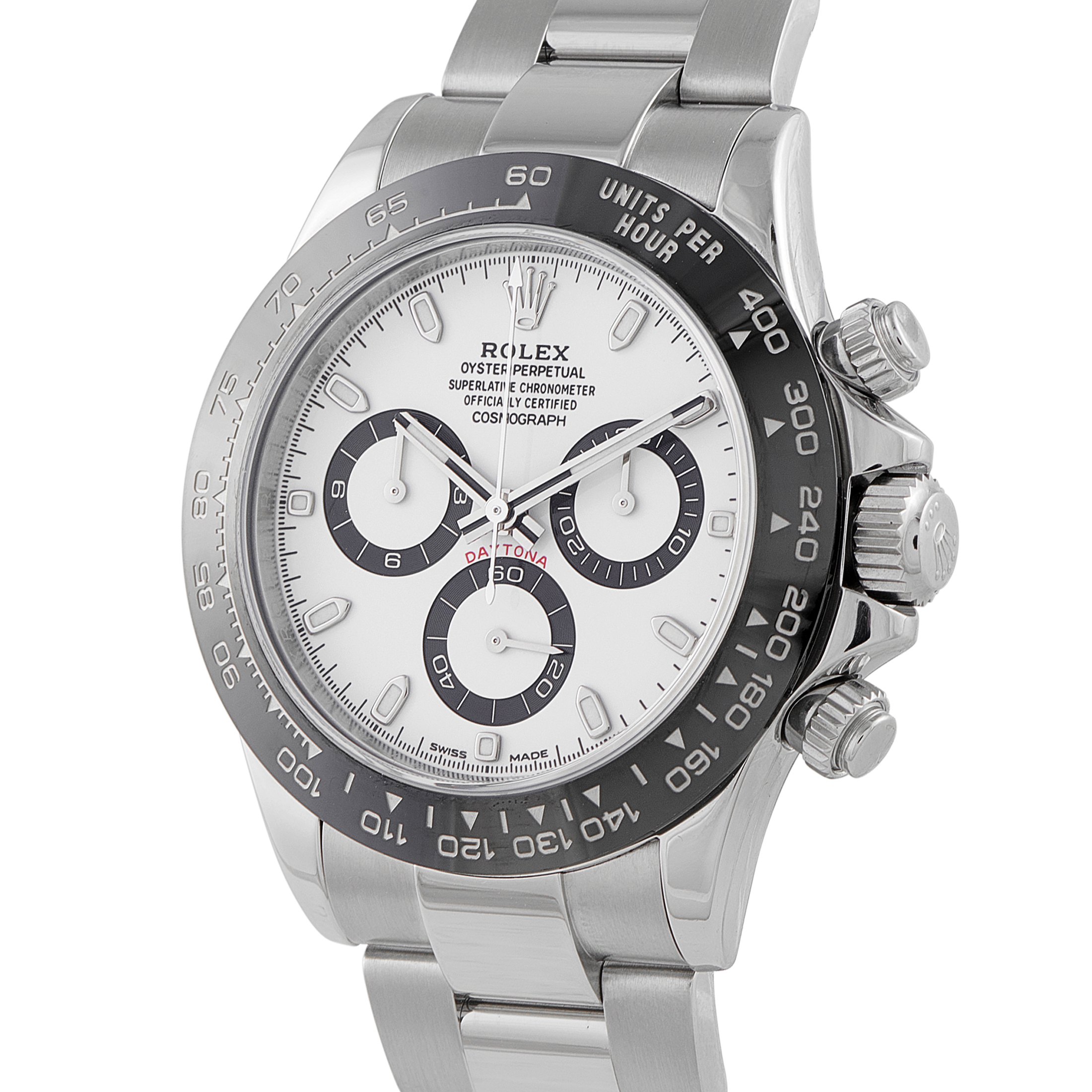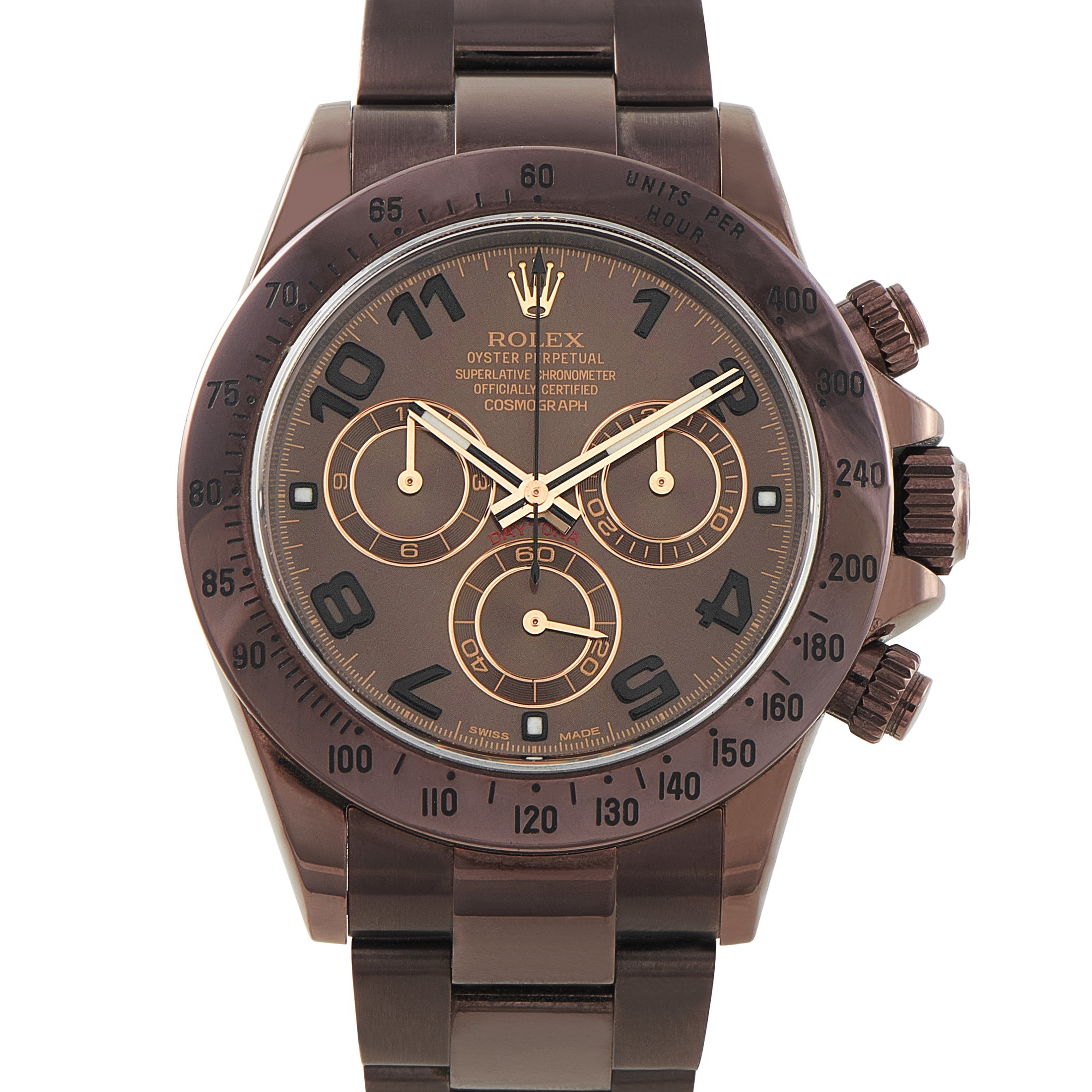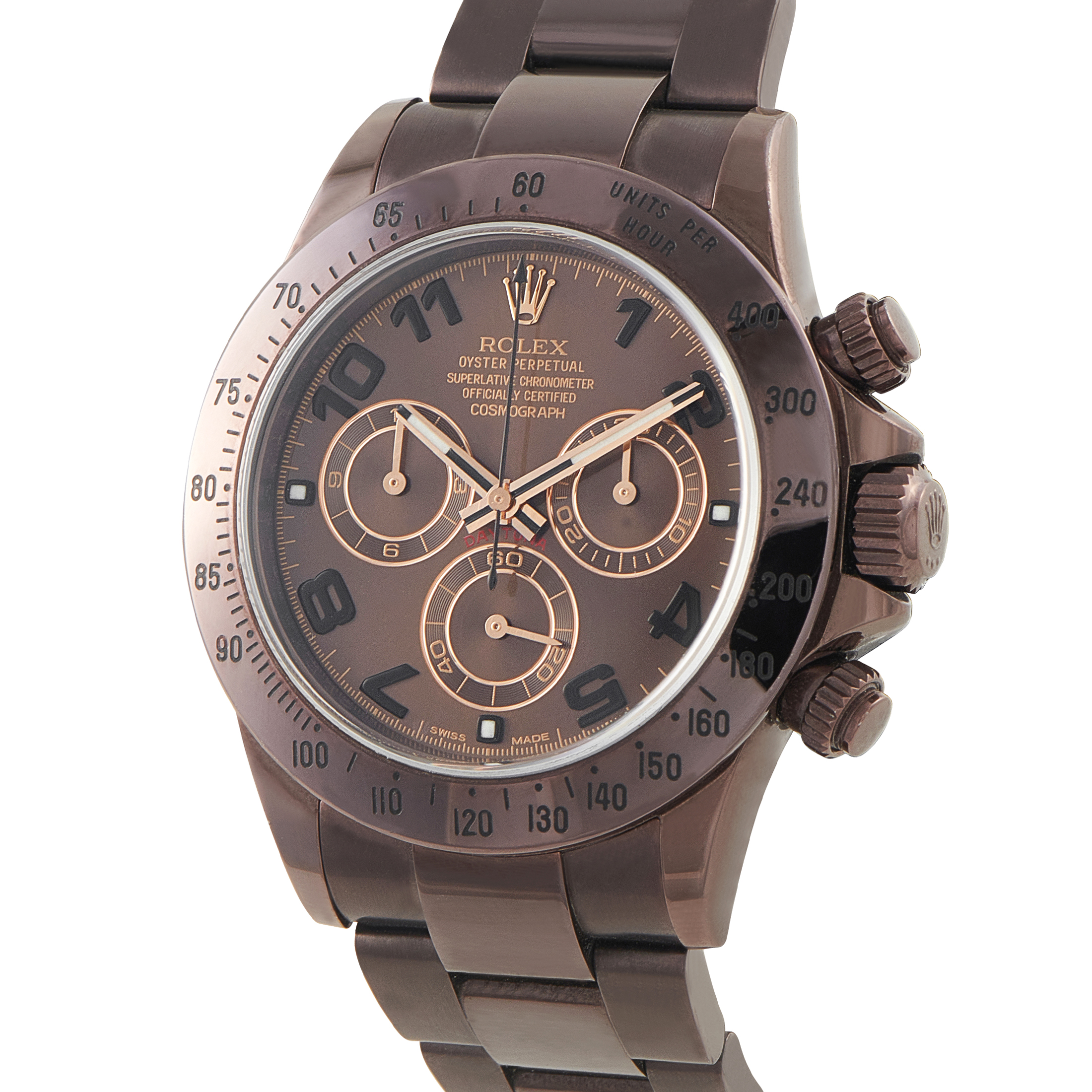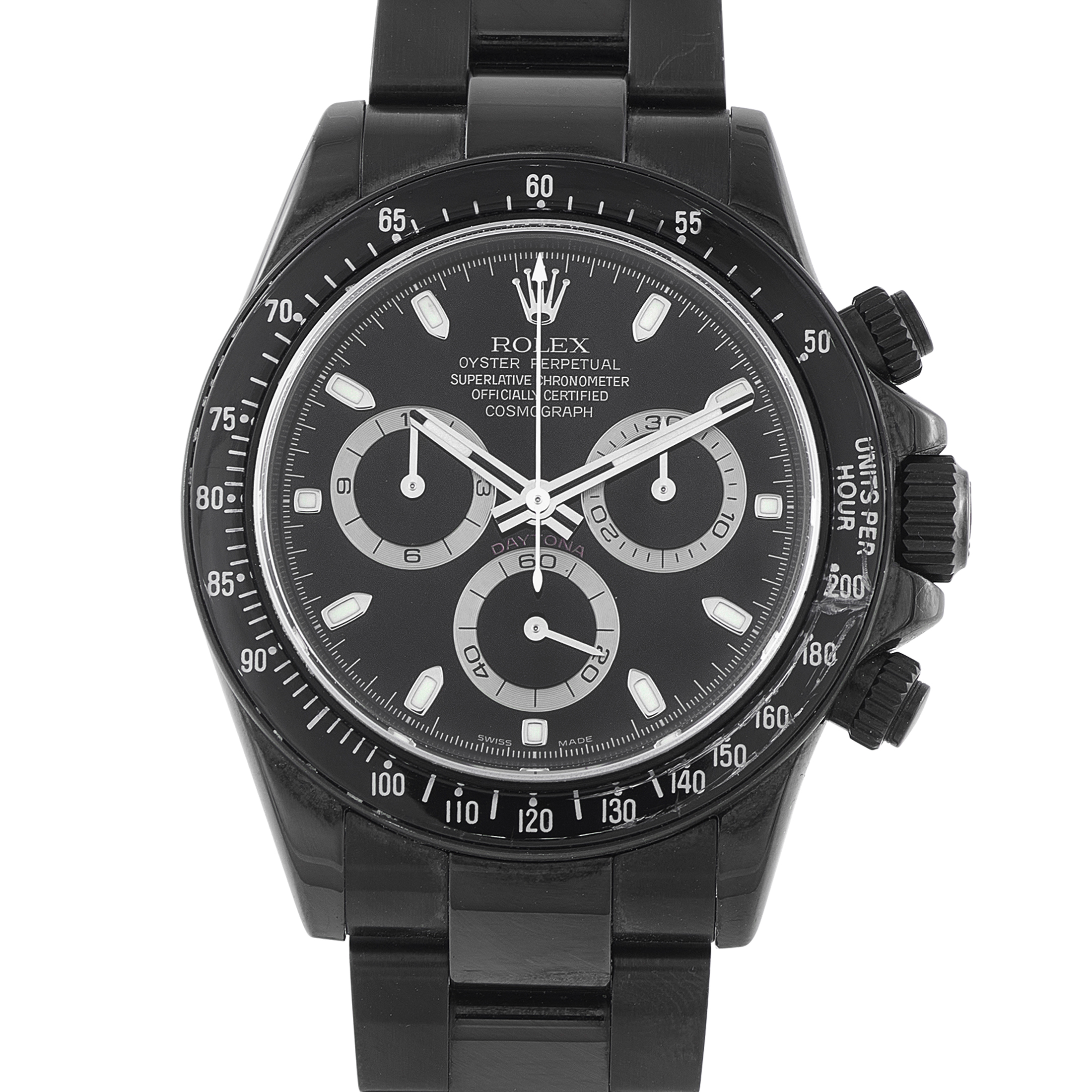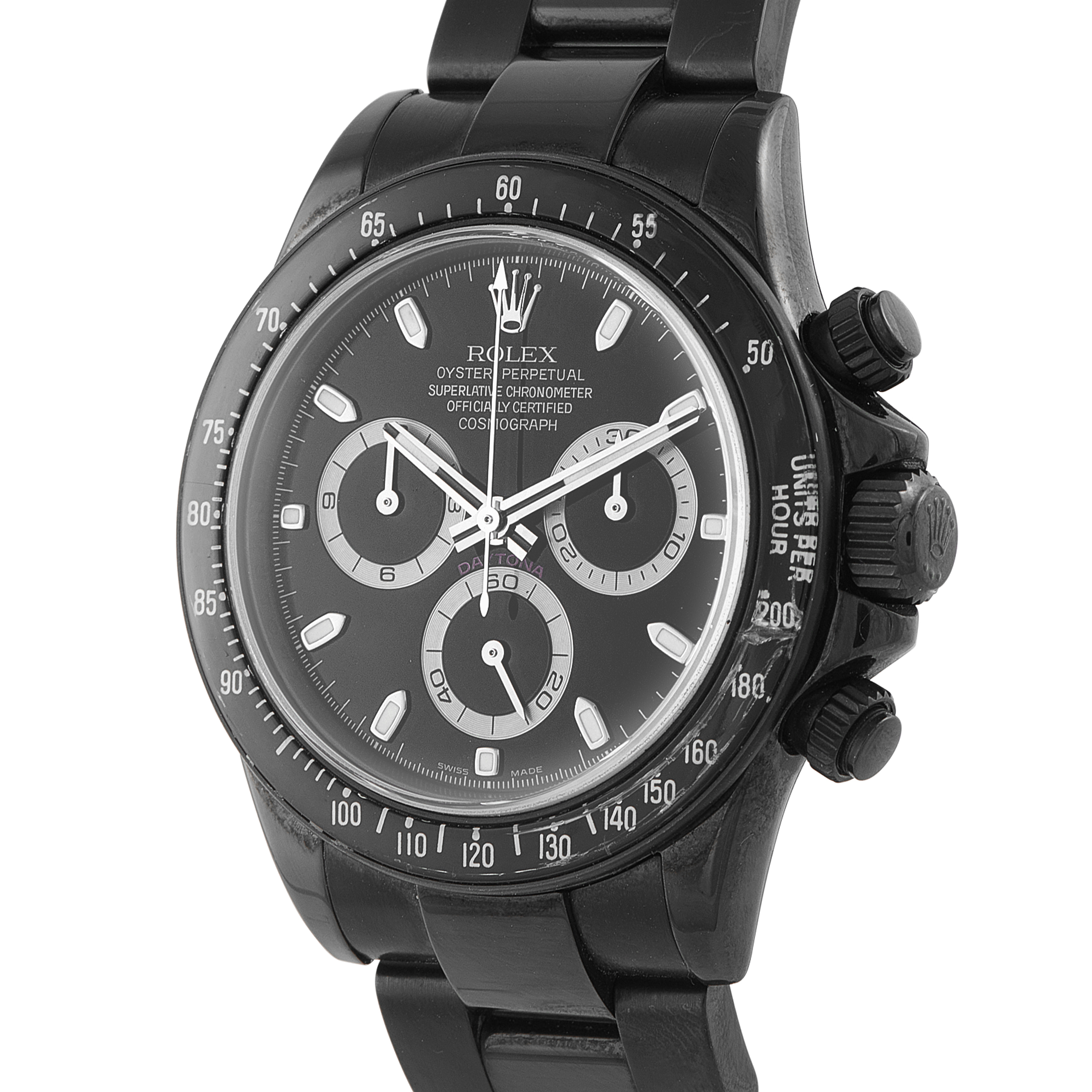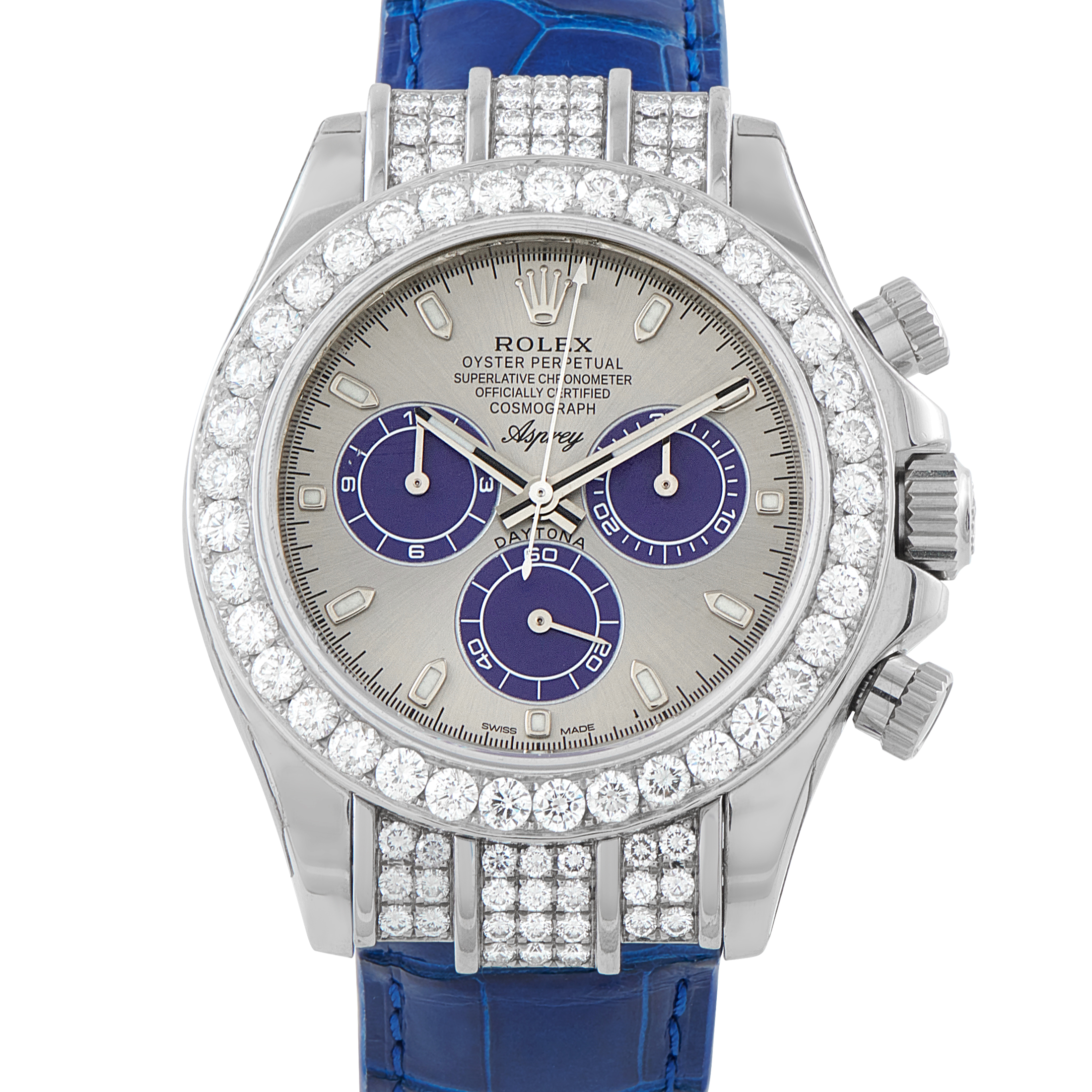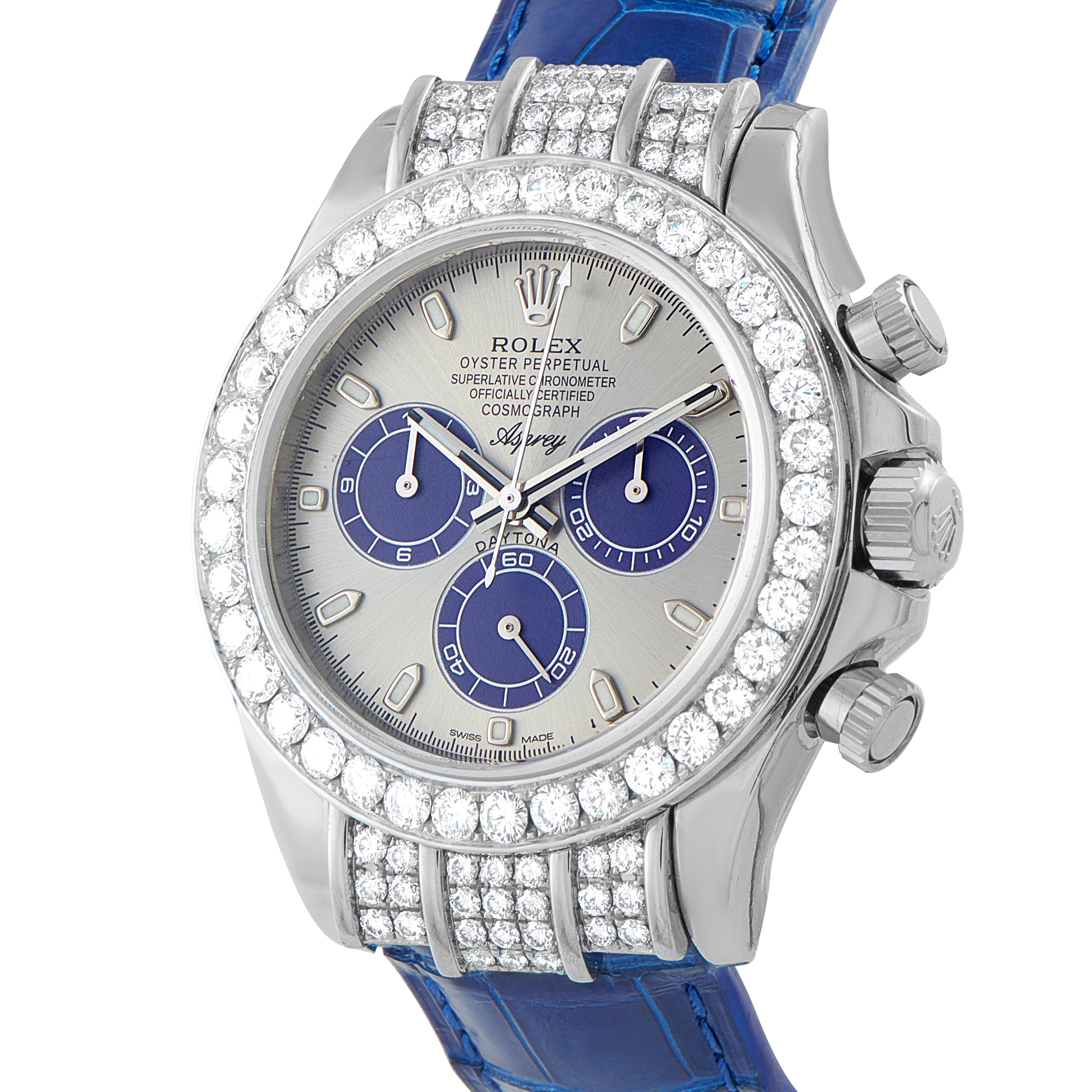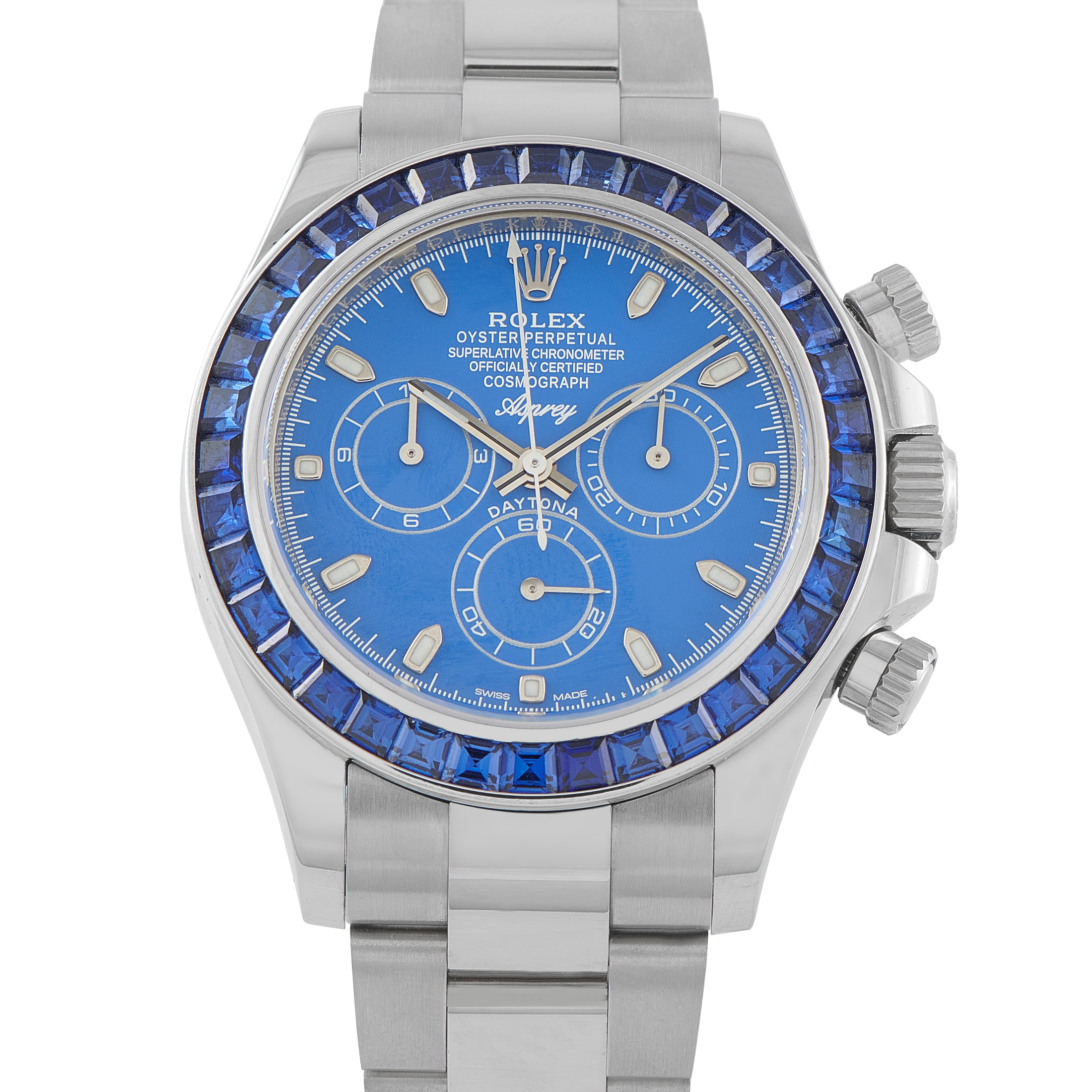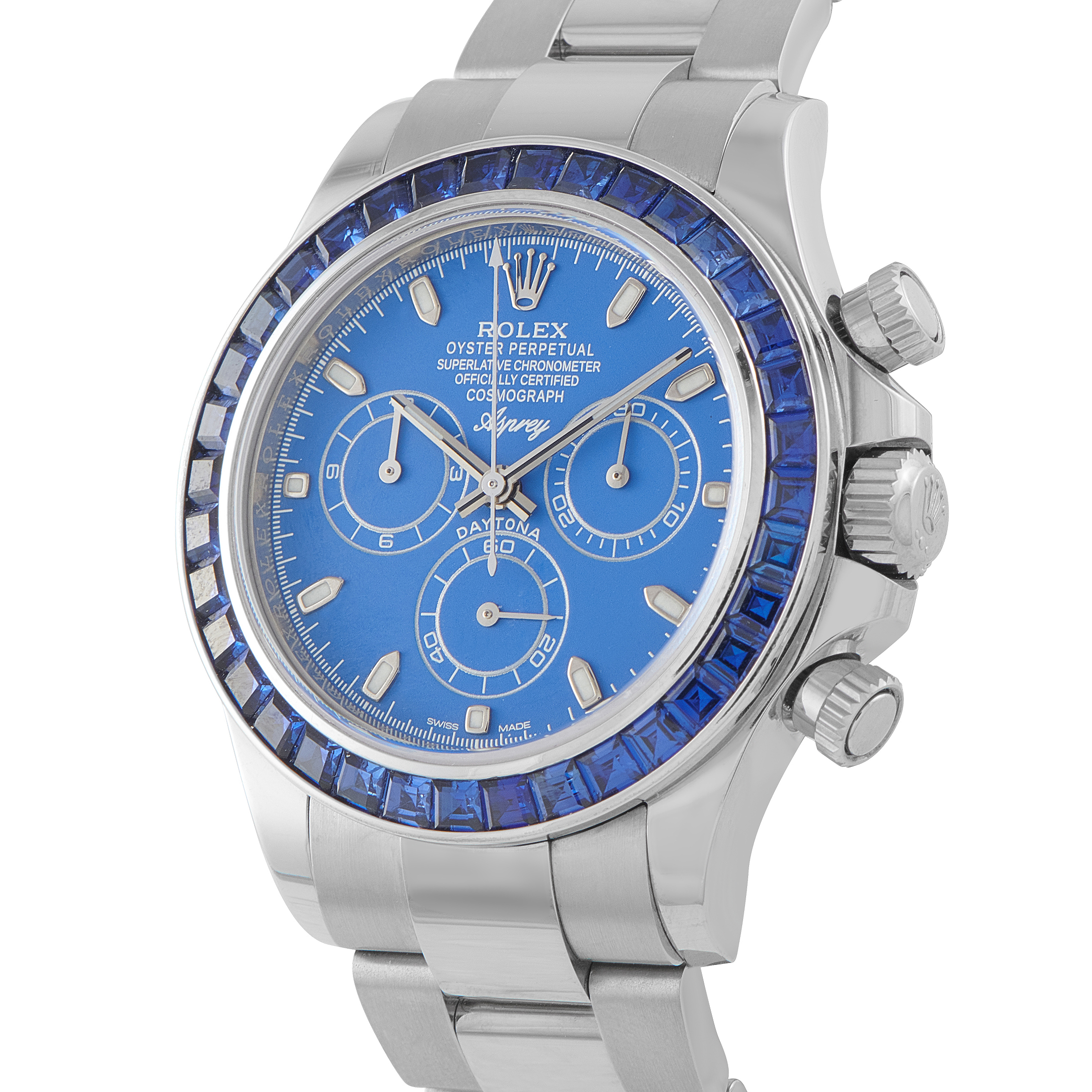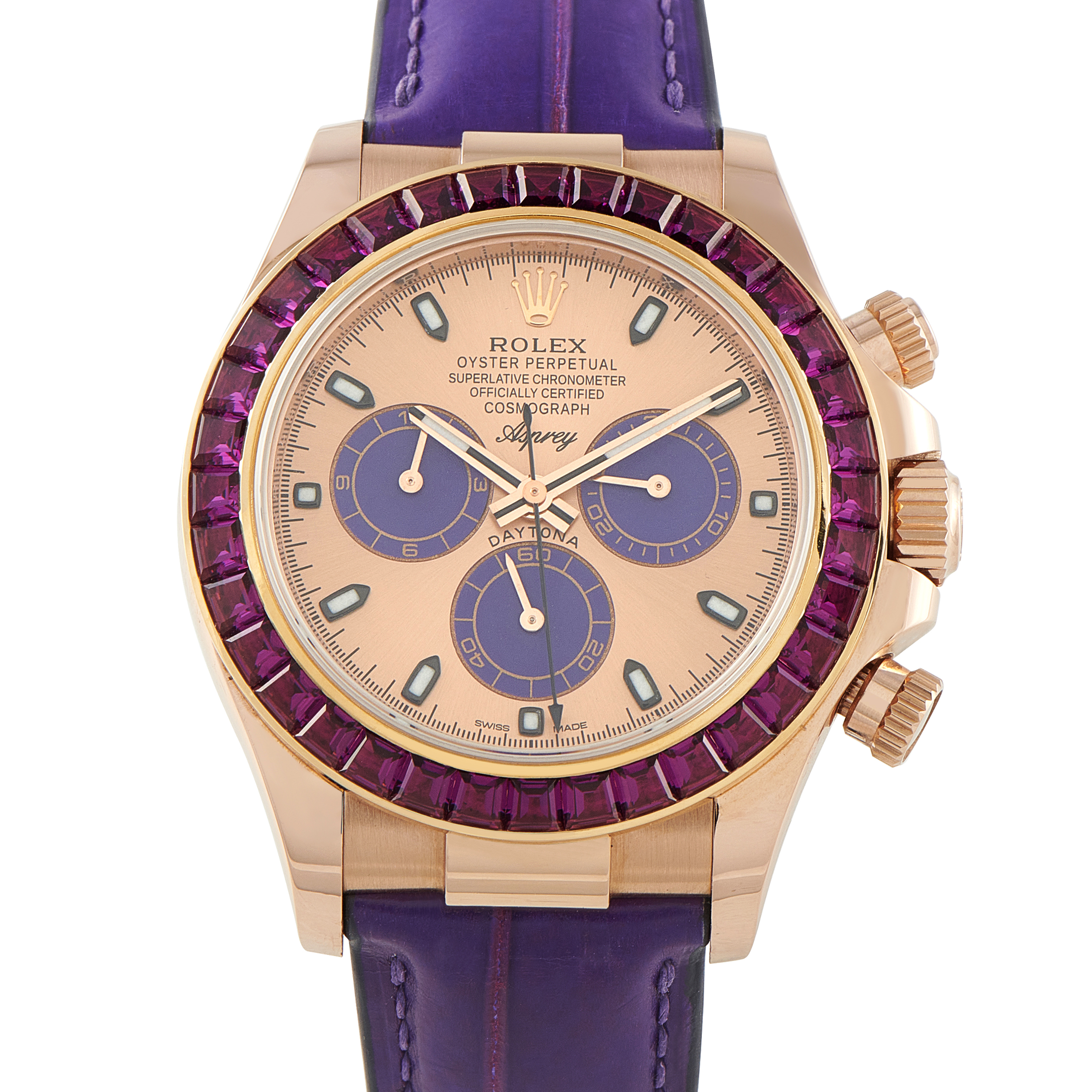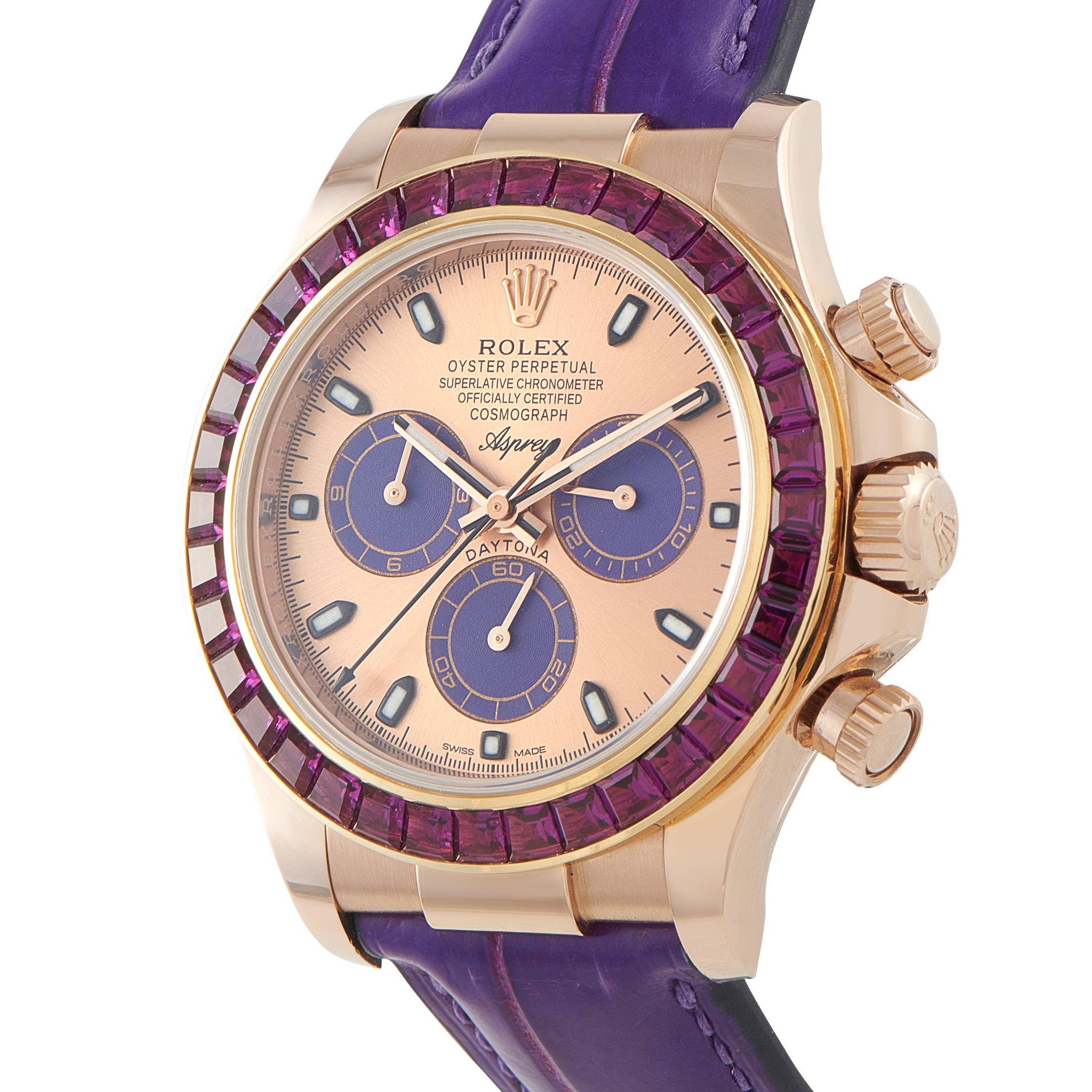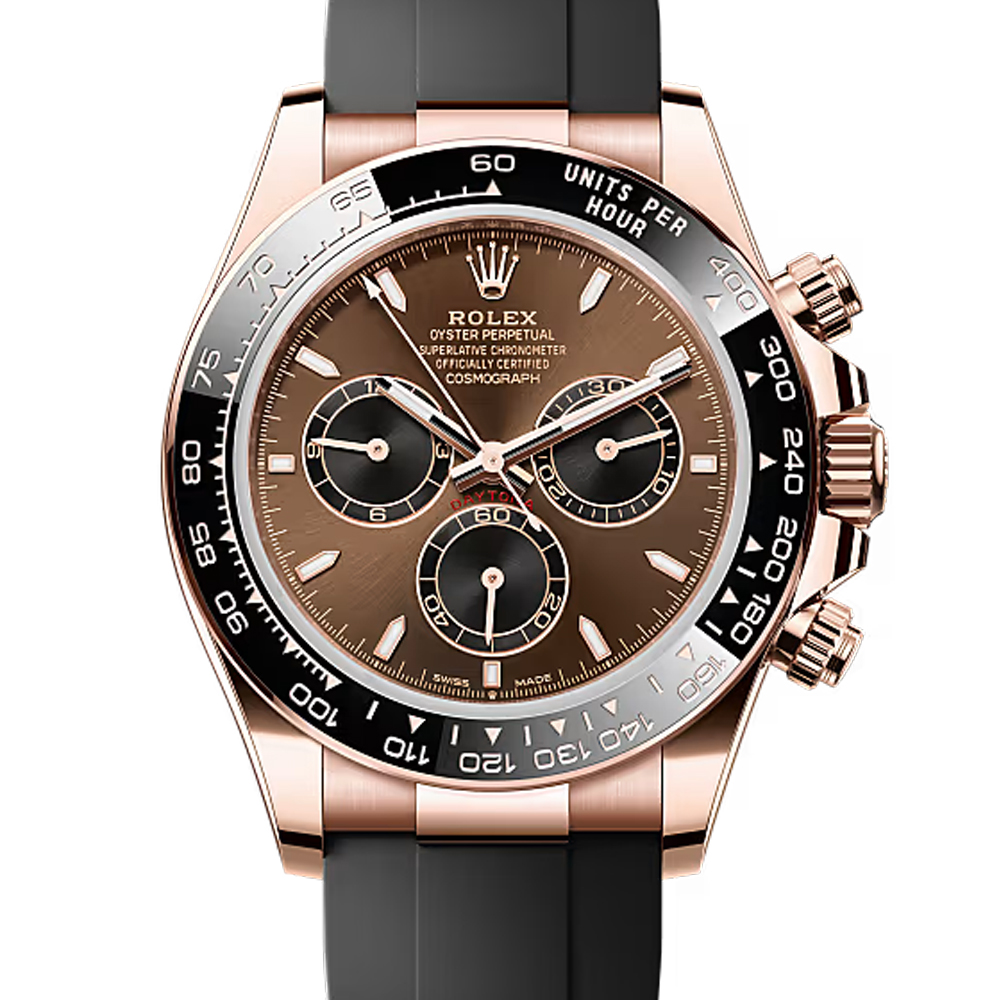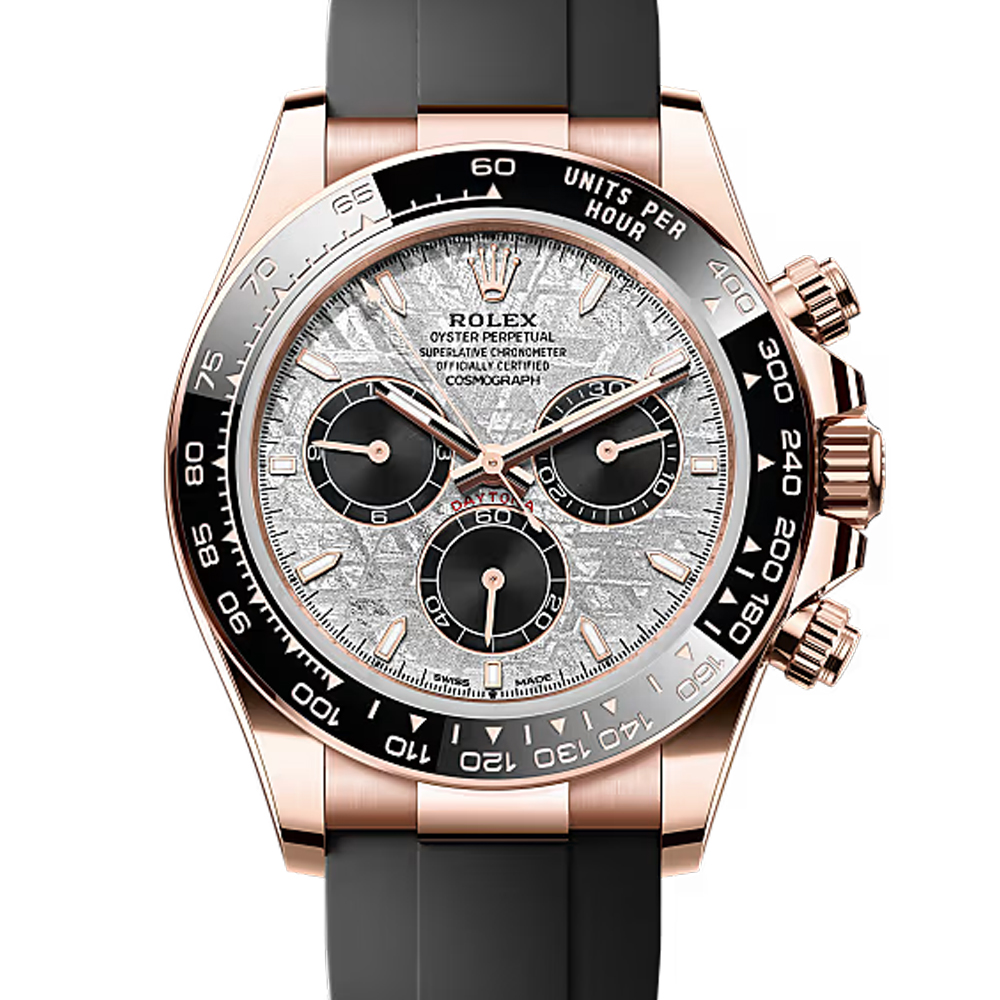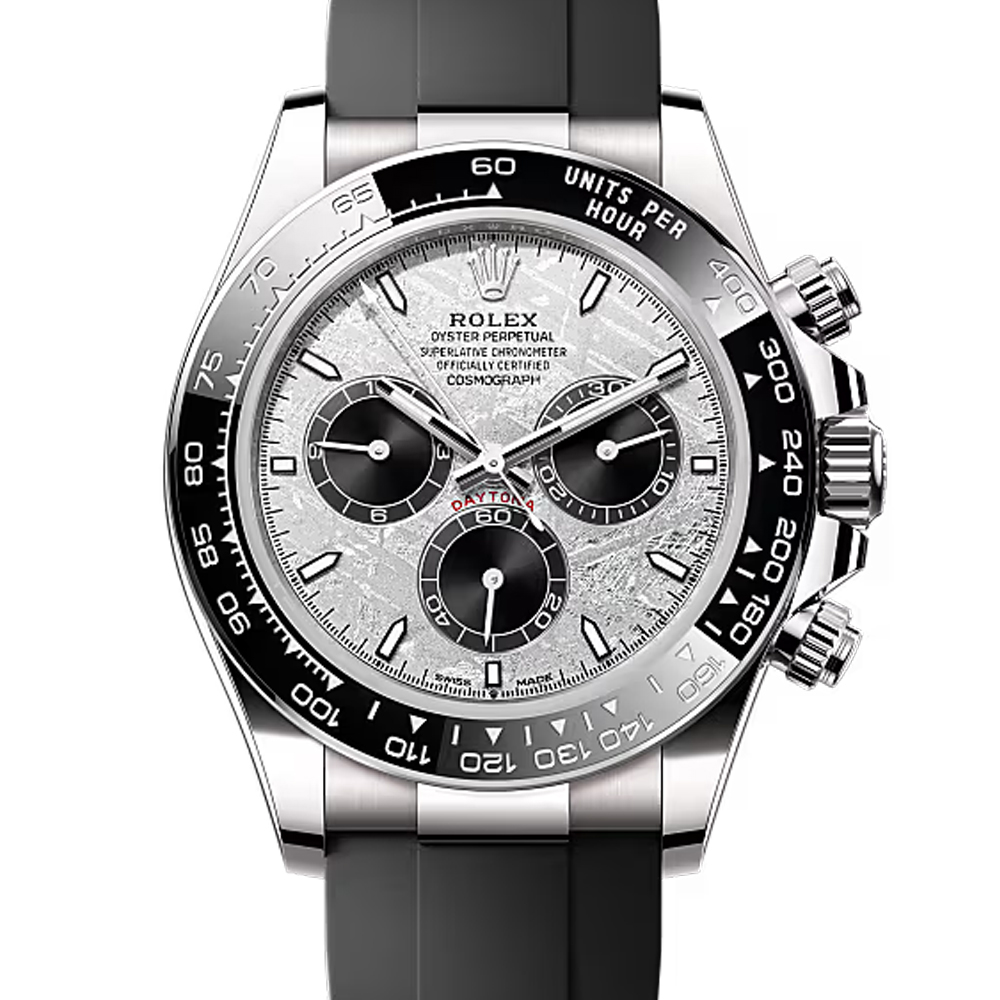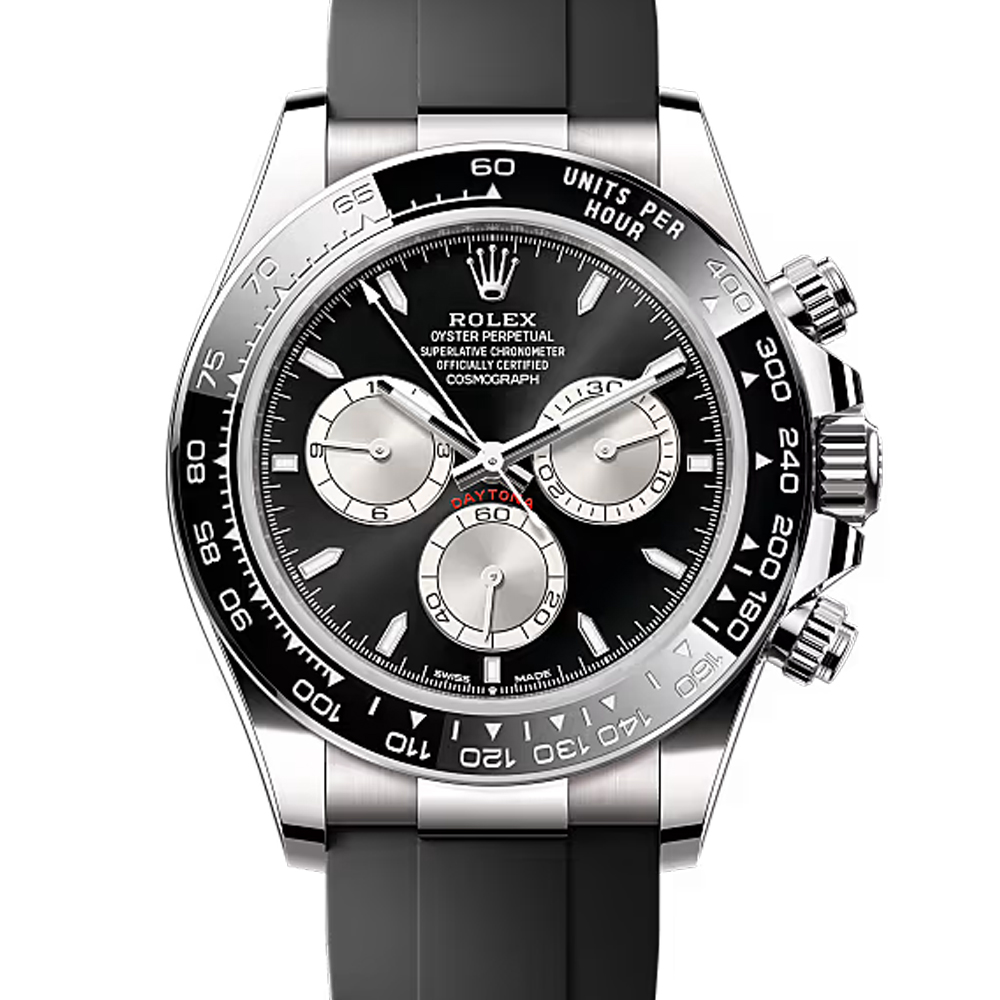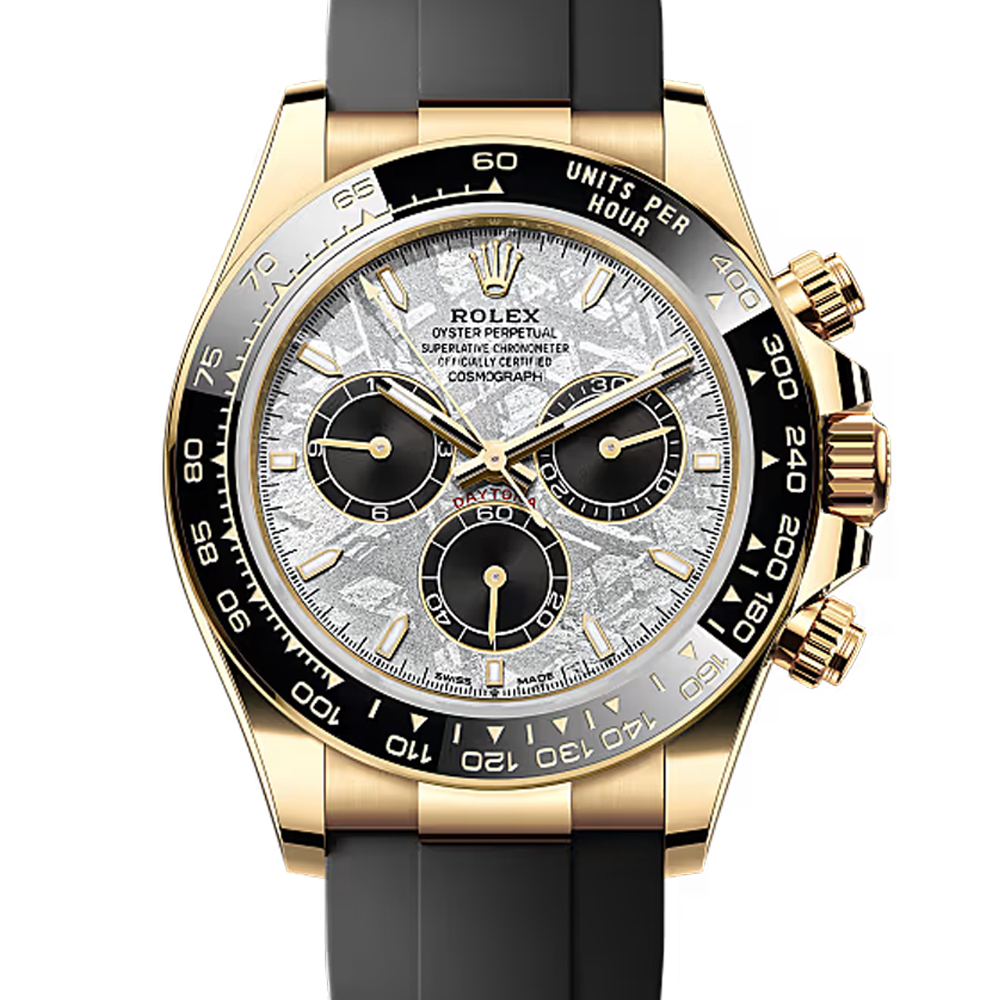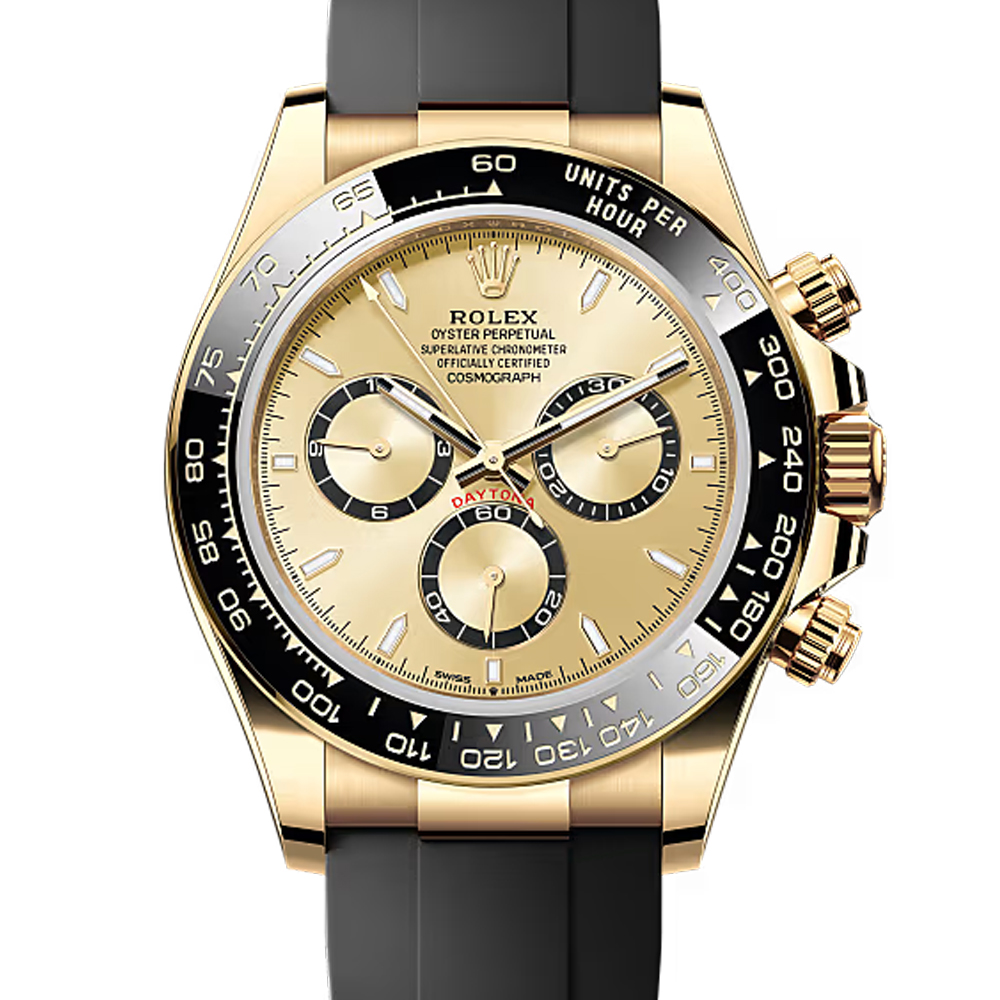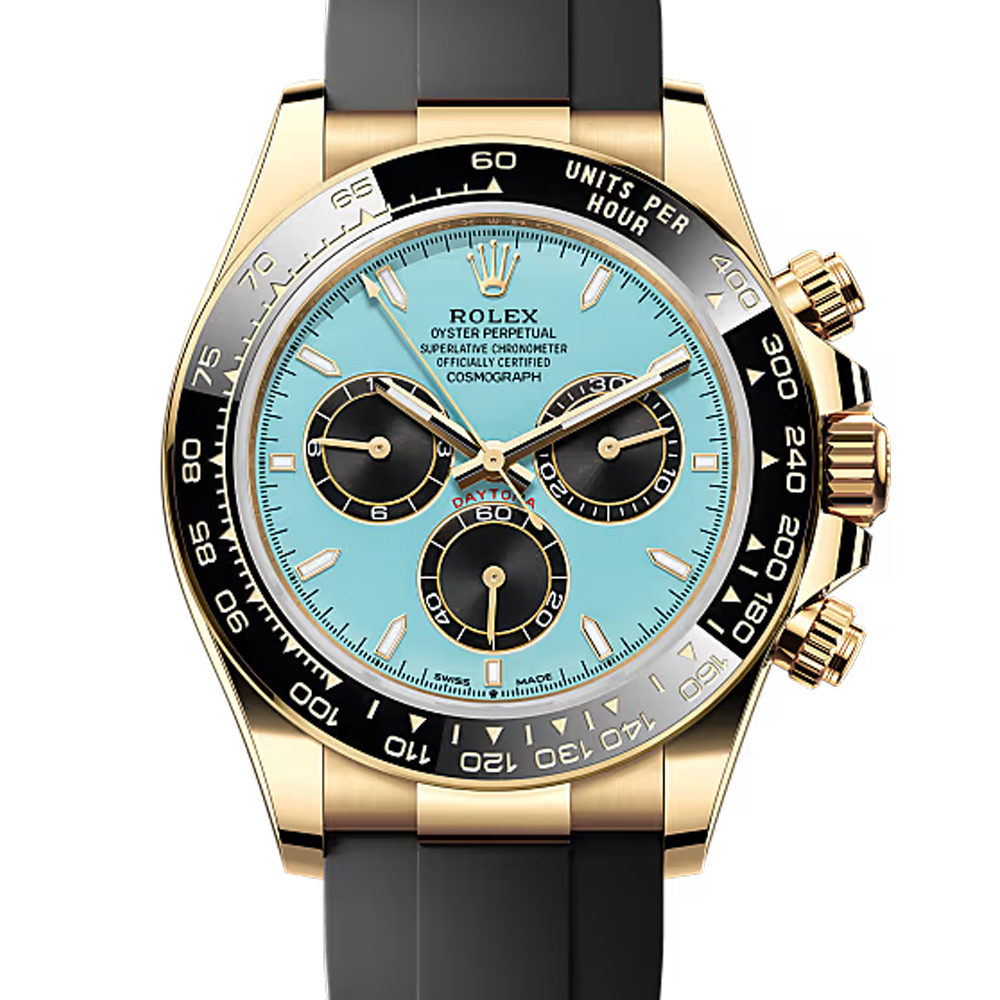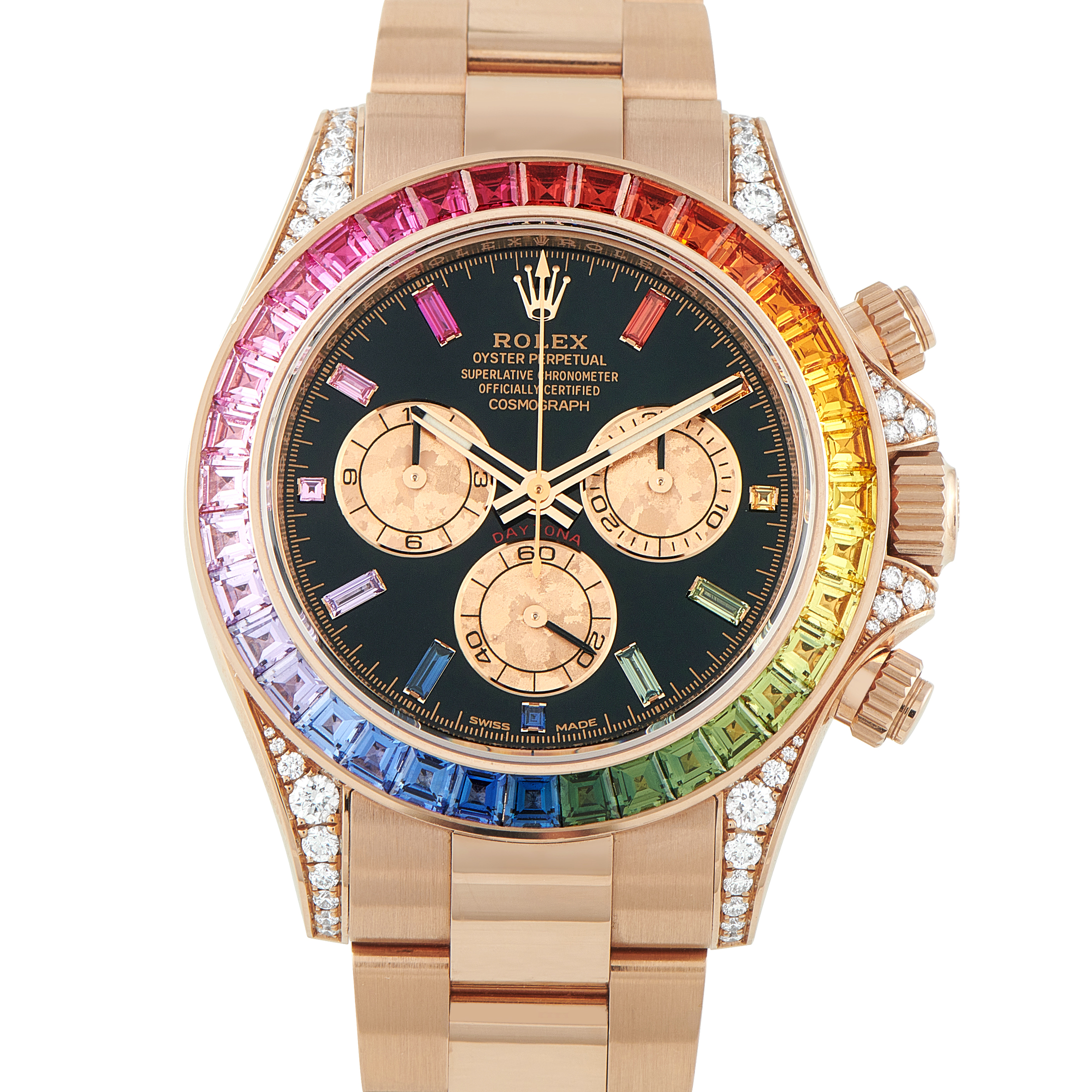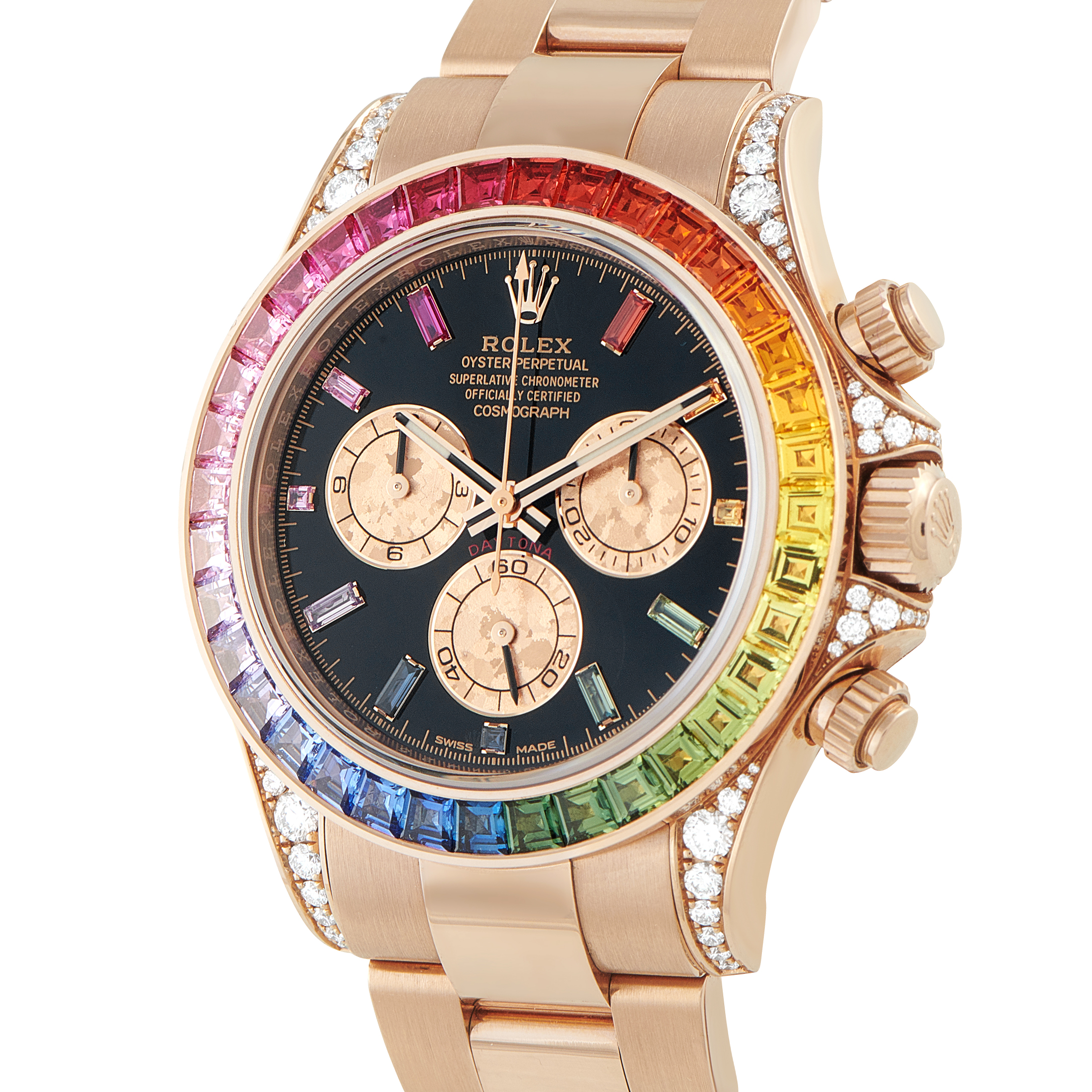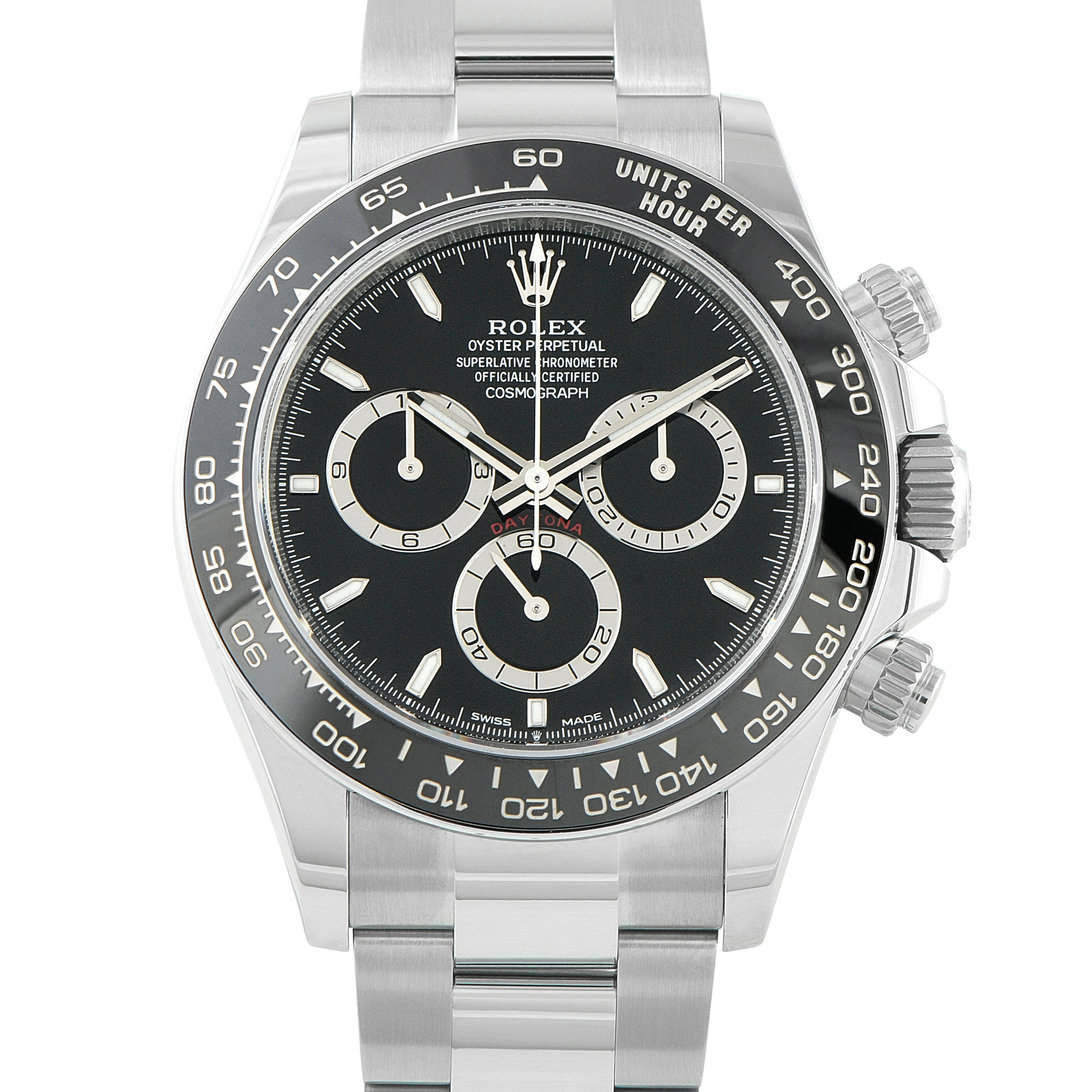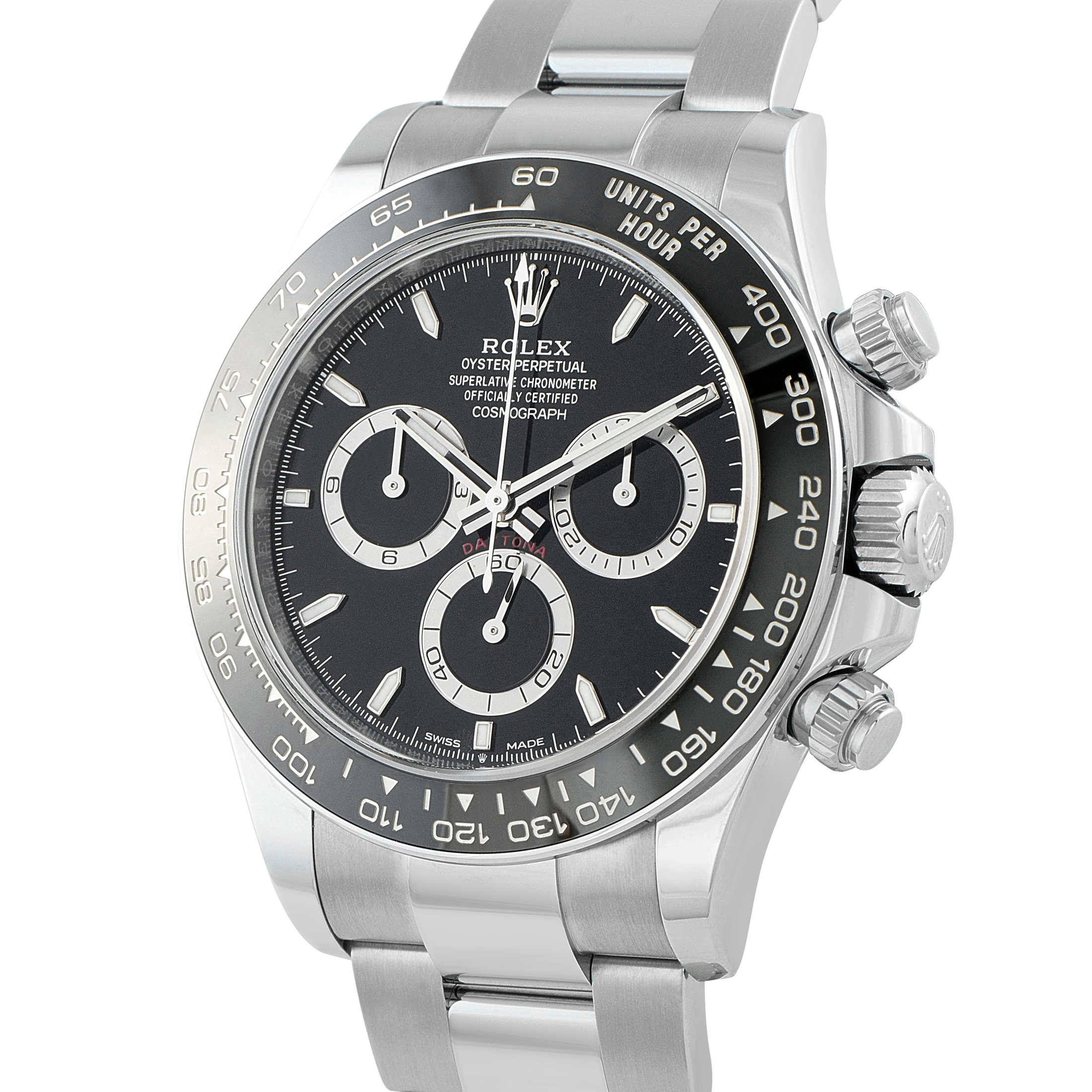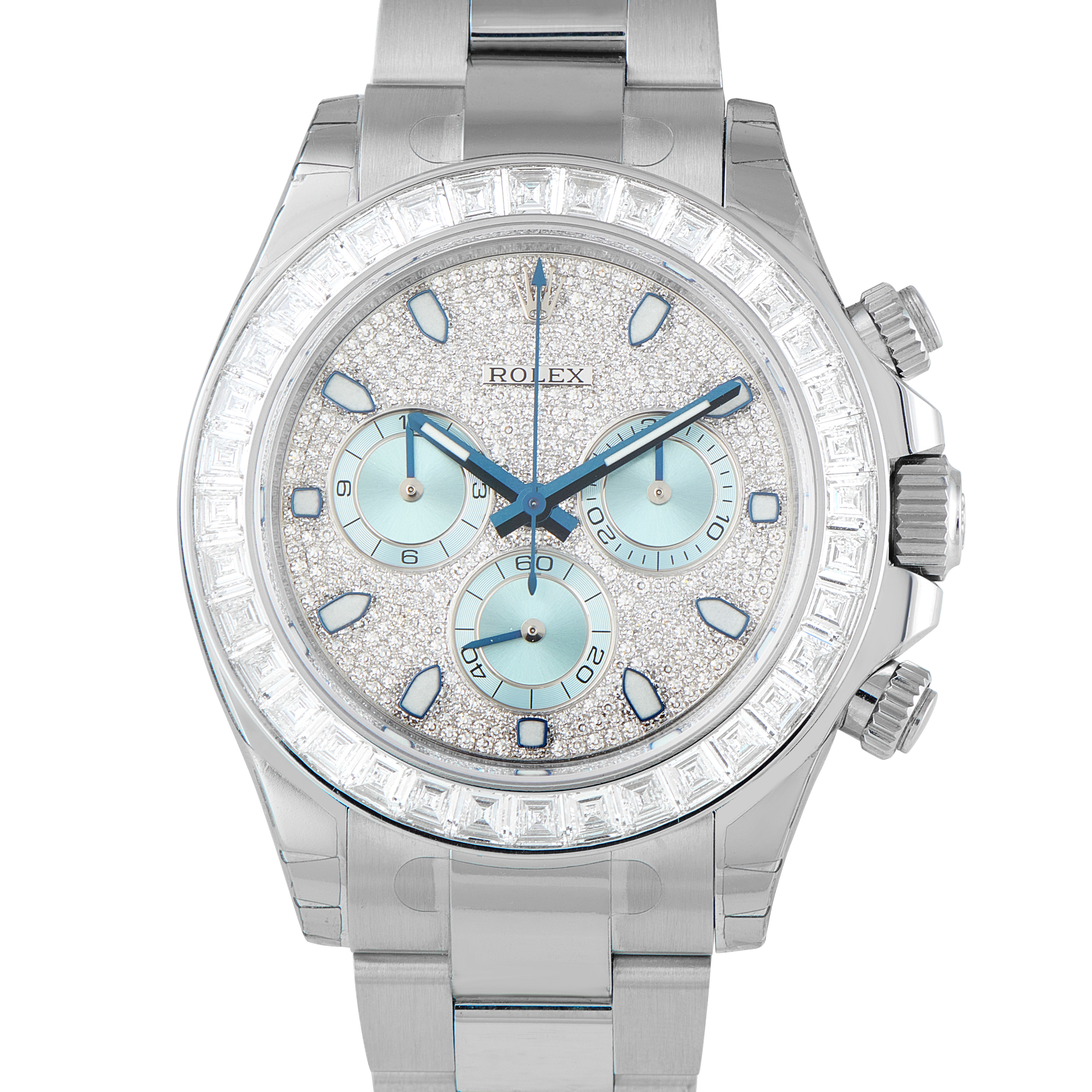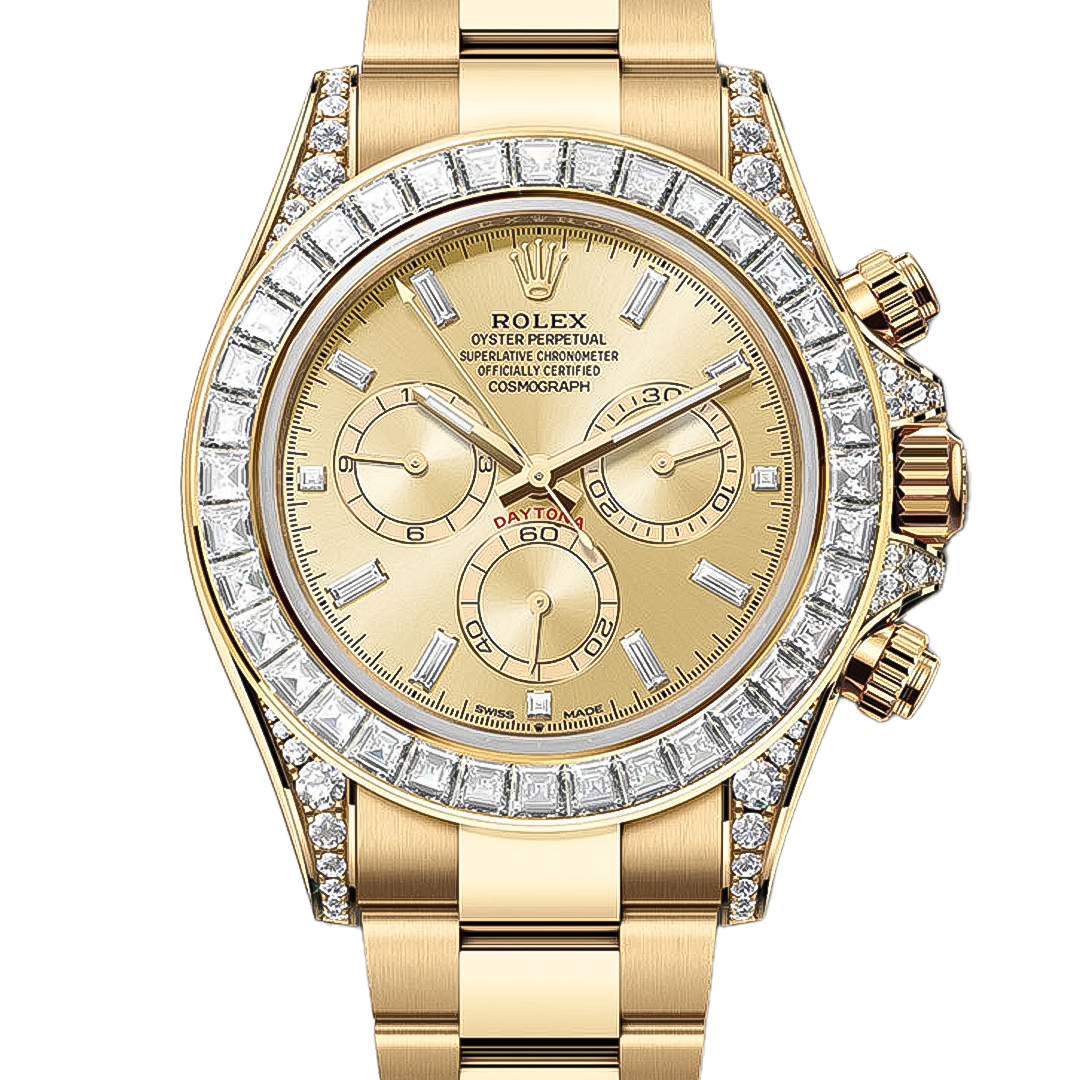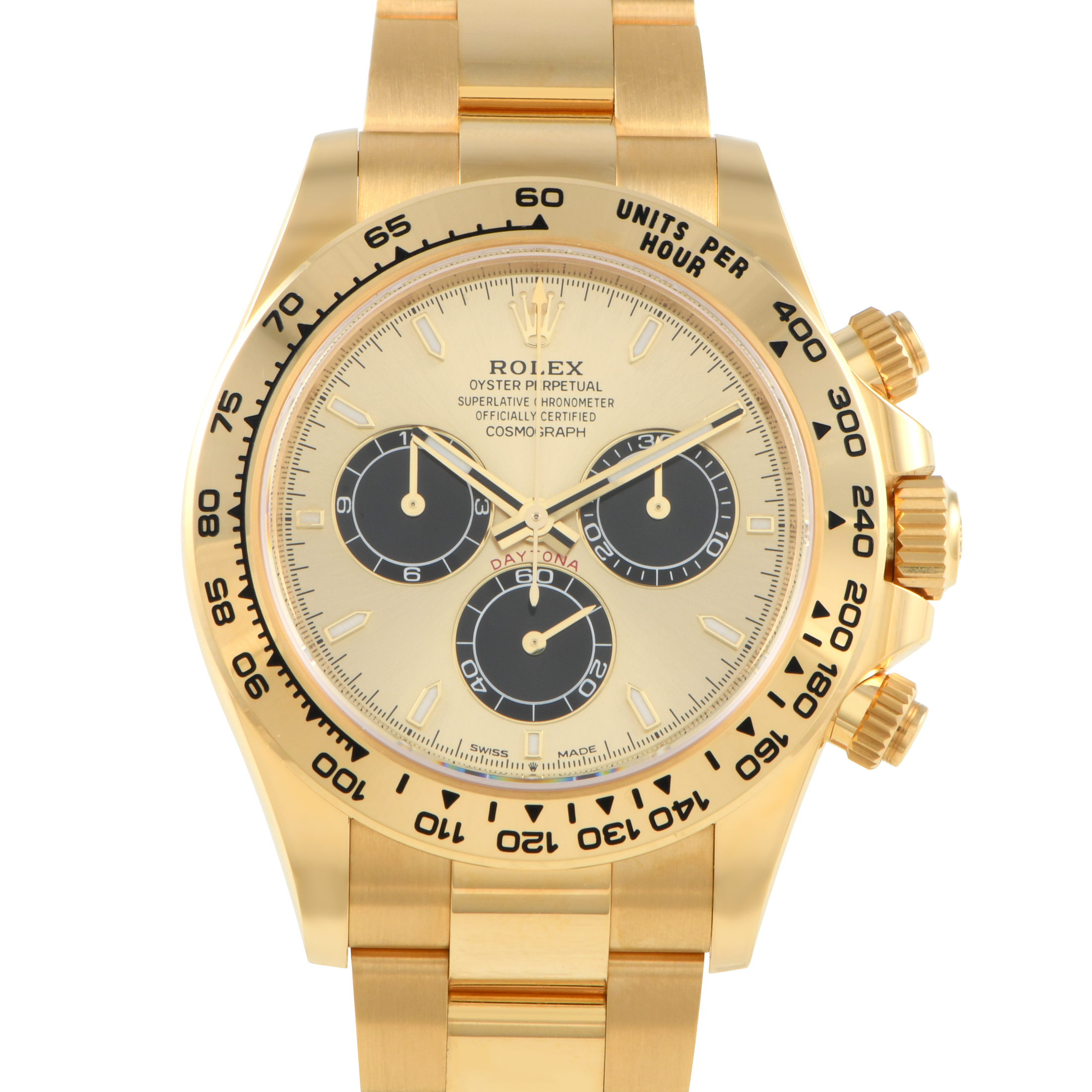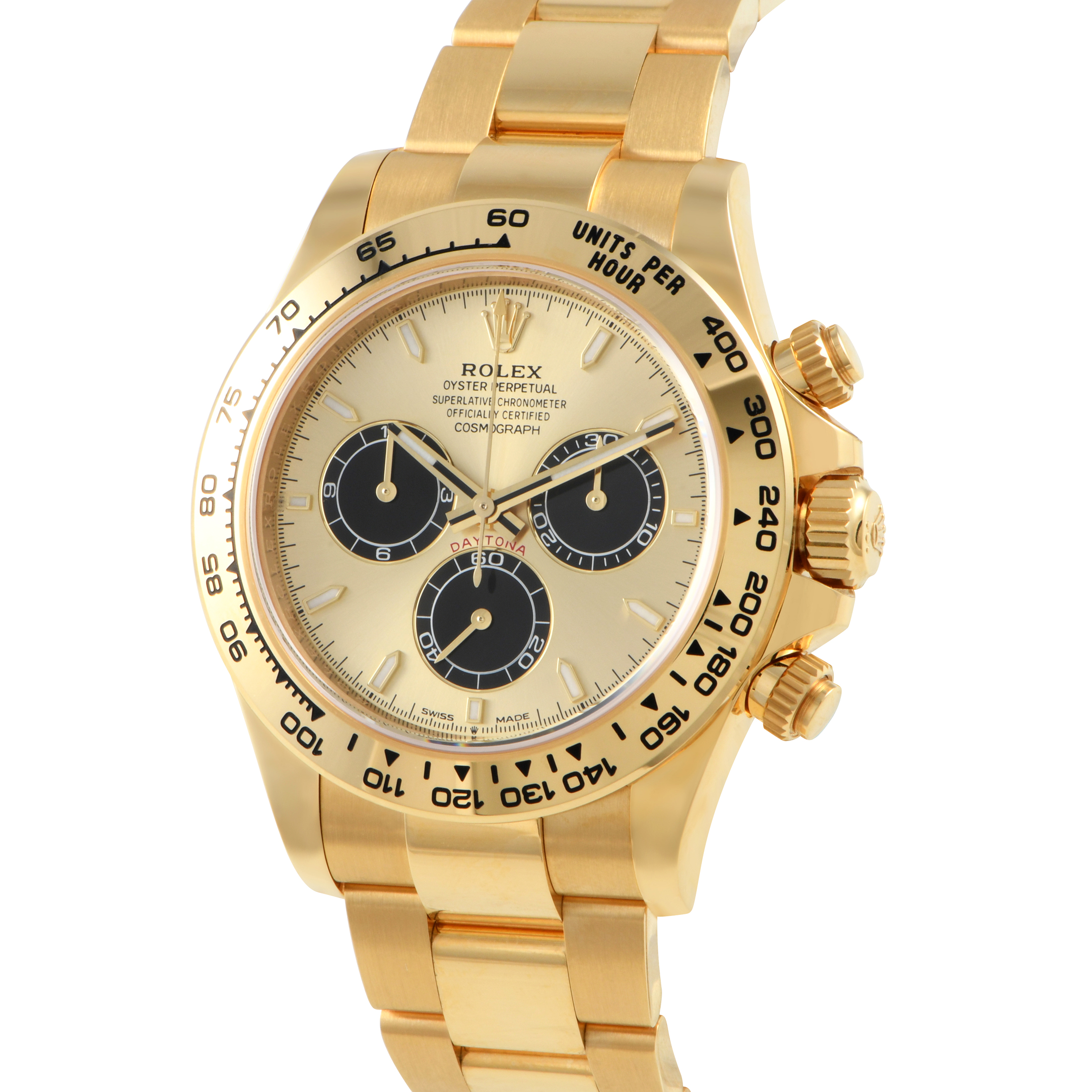While it faced a slow start, the Cosmograph Daytona has grown to become Rolex’s most valuable watch model. Introduced in the 1960s and benefiting from plenty of modern upgrades throughout the decades, the Rolex Daytona has come to define what a luxury chronograph should be.
Rolex Daytona History and Evolution
The Cosmograph Daytona, better known as the Daytona, is Rolex’s chronograph model that was introduced in 1963. The watch is inspired by motorsports and takes its name from the famed racing speedway in Florida. Rolex has made four main generations of the Daytona, each defined by the type of movement that powers the watch.

Rolex Daytona chronographs made from the 1960s until the late-1980s were manual-winding models powered by Valjoux-based movements. They feature smaller 38mm cases fitted with a pair of chronograph pushers to control the central chronograph hand on the dial. The metal or aluminum bezels have a tachymeter scale to measure average racing speeds or distances while the dials are home to three subsidiary dials. During the production of the manual-winding Daytona, Rolex offered the choice of standard dials or so-called “exotic dials,” characterized by Art Deco numerals and stylized hash-marks on the subdials. Daytona exotic dials are now known among collectors as the “Paul Newman” dial because the famous actor wore one. Vintage Rolex Daytona watches—particularly those with Paul Newman dials—are the most collectible (therefore, most expensive) vintage Rolex watches in the market. In 2017, Paul Newman’s very own Daytona “Paul Newman” shattered records for the most expensive Rolex ever sold when it was auctioned for US $17.8 million.
In 1988, Rolex replaced the manual-winding Daytona series with automatic Daytona watches, this time powered by Zenith El Primero-based movements. As a result, models from this particular generation are often referred to as “Zenith” Daytona watches. In addition to the new movement, the watches also received larger 40mm cases and restyled dials and bezels. What’s more, Rolex offered more material and bracelet options within the automatic Daytona range.

In the year 2000, Rolex unveiled a brand new Daytona collection that shared a similar style to the preceding generation but powered by in-house-made Rolex movements. The watches retained the same case size but the dial layout was slightly altered to accommodate the new movement (the chronograph hour counter and the small seconds subdials switched places). In 2011, Rolex introduced the first Daytona with a ceramic bezel. The ceramic bezel was initially available on a rose gold Daytona but the brand eventually made it available across other material options too. The steel and ceramic Daytona became particularly popular, trading for multiple times its retail price on the secondary market.
In 2023, Rolex introduced a whole new Daytona watch generation with minimally updated case and dial designs and new movements. The latest Daytona line also offers — for the first time in the brand’s modern history — a model with an exhibition caseback for a view of the movement inside.
Daytona watches, whether vintage, neo-vintage, or modern, are some of the most valuable luxury watches in today’s market.
Modern Daytona Design Features:
- Ceramic or metal bezels with tachymeter scales or gem-set bezels
- 40mm Oyster cases water resistant to 100 meters with screw-down chronograph pushers and winding crown
- Dials with Chromalight-coated luminous hands and hour markers for legality in low light
- Metal Oyster bracelets or rubber Oysterflex bracelets
- Scratch-resistant sapphire crystals
- Automatic movements with 72 hours of power reserve
Rolex Daytona Materials, Colorways, and Sizes
Depending on the model and specific reference, Daytona watches are available in 904L stainless steel (a.k.a. Oystersteel), yellow gold, two-tone steel and yellow gold, white gold, Everose gold, and platinum. What’s more, modern gold Daytona watches offer the choice between a matching metal bracelet or a black rubber Oysterflex bracelet.

Regular production Daytona watches either come with a Cerachrom ceramic bezel or a metal bezel, both engraved with tachymeter scales to highlight the watch’s association with racing. However, there are also lavish off-catalog gem-set Daytona watches that replace the tachymeter bezel with precious gemstones.
If we look at the entire scope of the Daytona line, dial choices are numerous, ranging from vintage classic white and black “Panda” to dressy champagne to exotic meteorite, and plenty in between.
More information about materials, bracelets, and dials:
Rolex Rose Gold: Every Everose Watch Produced by Rolex
A Complete Guide to Every Special Rolex Dial Ever Produced
An Introduction to Common Materials Used in Watchmaking
How Many Links Does a Rolex Come With?
A Primer on the Different Types of Watch Bands, Straps, and Bracelets
Vintage Daytona watches with manual winding movements have smaller 38mm cases. Rolex upgraded the collection with automatic movements in 1988, and the Daytona has always featured a 40mm case since then.
Rolex Daytona Reference Numbers and Serial Numbers
The six-decade history of the Daytona watch has produced four generations of watches. Each generation offers a bevy of references, which are outlined in the below tables.
On the other hand, if you’re looking for Daytona serial numbers rather than Daytona references, then read our Rolex Serial Numbers: The Ultimate Guide.
It’s also important to note that many Daytona watches are not called by their reference numbers but by nicknames instead. For a detailed rundown of Daytona nicknames, read our Go-To Guide to Rolex Nicknames.
Current Daytona References 1265xx (Introduced in 2023)
| Reference | Case | Bezel | Bracelet | Caliber |
| 126500LN | Stainless Steel | Black Cerachrom | Oyster | 4131 |
| 126503 | Stainless Steel / Yellow Gold | Yellow Gold | Oyster | 4131 |
| 126508 | Yellow Gold | Yellow Gold | Oyster | 4131 |
| 126518LN | Yellow Gold | Black Cerachrom | Oysterflex | 4131 |
| 126509 | White Gold | White Gold | Oyster | 4131 |
| 126519LN | White Gold | Black Cerachrom | Oysterflex | 4131 |
| 126505 | Everose Gold | Everose Gold | Oyster | 4131 |
| 126515LN | Everose Gold | Black Cerachrom | Oysterflex | 4131 |
| 126506 | Platinum Display Caseback | Brown Cerachrom | Oyster | 4131 Decorated with Côtes de Genève |
Learn more: New and Discontinued Rolex Watches in 2023
Daytona 126500LN vs. 116500LN
Rolex replaced the highly popular Daytona 116500LN with the updated Daytona 126500LN in 2023. While the two watches look very similar at first glance, there are indeed a few differences between them. Let’s compare.
| Reference | Case | Bezel | Dials | Lugs | Bracelet | Cal. |
| 126500LN | 40mm 11.9mm Steel | Black Cerachrom w/ Steel Ring | White or Black Smaller Indices Thinner Subdial Rings | Symmetric Thicker | Oyster | 4131 |
| 116500LN | 40mm 12.4mm Steel | Black Cerachrom | White or Black Larger Indices Thicker Subdial Rings | Asymmetric Thinner | Oyster | 4130 |
Both reference 126500LN and 116500LN are stainless steel Daytona watches with black ceramic bezels and three-link Oyster bracelets. What’s more, they are both available with black dials or white “Panda” dials.
One difference between the Daytona ref. 126500LN and 116500LN is the shape of the lugs. The Daytona 116500LN has asymmetrical lugs where the lugs on the winding crown side are thinner than on the other side. Conversely, the newer Daytona ref. 126500LN has lugs that are not only more equal on both sides but also slightly thicker.
Another difference between the Daytona 116500LN and 126500LN is the newer model now includes a steel ring around the Cerachrom bezel whereas the older version did not. Although on paper the Daytona 116500LN case measures 40mm, if you measure it with a caliper, it’s actually about 38.5mm. On the other hand, because of the steel ring and slightly bigger crown guards, the newer Daytona 126500LN case is now larger and wears closer to its stated 40mm measurement. The newer case is, however, about 0.5mm thinner (11.9mm) than the older model.
Rolex also updated the dial of the newer 126500LN and compared to the 116500LN it has smaller hour markers and thinner subdial rings.
Finally, the biggest difference between the Daytona 116500LN vs. 126500LN is the movement inside the watch. While both are Rolex in-house-made automatic chronograph movements with 72 hours of power reserve, the Daytona 16500LN runs on Caliber 4130 while the Daytona 126500LN is fitted with Caliber 4131, which benefits from fewer parts and the addition of Rolex’s proprietary Chronergy escapement.
Discontinued Daytona 1165xx References (2000 – 2023)
| Reference | Case | Bezel | Band | Caliber |
| 116500LN | Stainless Steel | Black Cerachrom | Oyster | 4130 |
| 116520 | Stainless Steel | Stainless Steel | Oyster | 4130 |
| 116503 | Stainless Steel / Yellow Gold | Yellow Gold | Oyster | 4130 |
| 116523 | Stainless Steel / Yellow Gold | Yellow Gold | Oyster | 4130 |
| 116508 | Yellow Gold | Yellow Gold | Oyster | 4130 |
| 116523 | Yellow Gold | Yellow Gold | Oyster | 4130 |
| 116518 | Yellow Gold | Yellow Gold | Leather | 4130 |
| 116518LN | Yellow Gold | Black Cerachrom | Oysterflex | 4130 |
| 116598RBOW “Rainbow” | Yellow Gold | Multicolored Sapphires | Oyster | 4130 |
| 116578SACO | Yellow Gold | Cognac Sapphires | Oyster | 4130 |
| 116588SACO | Yellow Gold | Cognac Sapphires | Oysterflex | 4130 |
| 116598SACO “Leopard” | Yellow Gold | Cognac Sapphires | Oyster | 4130 |
| 116568 | Yellow Gold | Baguette Diamonds | Oyster | 4130 |
| 116588TBR “Eye of the Tiger” | Yellow Gold | Baguette Diamonds | Oysterflex | 4130 |
| 116509 | White Gold | White Gold | Oyster | 4130 |
| 116519 | White Gold | White Gold | Leather | 4130 |
| 116519LN | White Gold | Black Cerachrom | Oysterflex | 4130 |
| 116599RBOW “Rainbow” | White Gold | Multicolored Sapphires | Oyster | 4130 |
| 116599 4RU | White Gold | Diamonds & Rubies | Oyster | 4130 |
| 116589 RBR | White Gold | Diamonds | Oyster | 4130 |
| 116505 | Everose Gold | Everose Gold | Oyster | 4130 |
| 116515LN | Everose Gold | Black Cerachrom | Oysterflex or Leather | 4130 |
| 116595RBOW “Rainbow” | Everose Gold | Multicolored Sapphires | Oyster | 4130 |
| 116506 “Platona” | Platinum | Brown Cerachrom | Oyster | 4130 |
| 116576TBR “Platona” | Platinum | Baguette Diamonds | Oyster | 4130 |
Daytona 116500LN vs. 116520
When Rolex introduced the Daytona 16500LN in 2016, it became the must-have Rolex sports watch to own. There was an absolute frenzy around the watch and its introduction is largely responsible for the broader Rolex waitlist and shortage we’re now witnessing at authorized dealers. The Daytona ref. 16500LN replaced the Daytona 116520, which was in production from 2000 until 2016. Let’s outline the differences and similarities by comparing the Daytona 116500LN vs. 116520.
| Reference | Case | Bezel | Dials | Subdials | Bracelet | Cal. |
| 116500LN | 40mm Steel | Black Cerachrom | White or Black | Black Rings on White Silver Rings on Black | Oyster | 4130 |
| 116520 | 40mm Steel | Steel | White or Black | Silver Rings | Oyster | 4130 |
Both the 116520 and 116500 are stainless steel Daytona watches that come with the choice of white or black dials. They are both fitted with steel Oyster bracelets and include 40mm cases that are water-resistant to 100 meters. Furthermore, they both run on the in-house-made Rolex Caliber 4130 automatic chronograph movement.
The biggest difference between the Daytona 116520 and 116500 is that the former includes a steel bezel engraved while the latter is furnished with a black Cerachrom ceramic bezel. Furthermore, the Daytona 116520 has silver subdial rings on both black and white dials while the Daytona 116500LN includes black rings on the white dial and silver rings on the black dial.
Neo-Vintage Daytona “Zenith” 165xx Reference (1988 – 2000)
| Reference | Case | Bezel | Band | Caliber |
| 16520 | Stainless Steel | Stainless Steel | Oyster | 4030 |
| 16523 | Stainless Steel / Yellow Gold | Yellow Gold | Oyster | 4030 |
| 16528 | Yellow Gold | Yellow Gold | Oyster | 4030 |
| 16518 | Yellow Gold | Yellow Gold | Leather | 4030 |
| 16568 | Yellow Gold | Diamonds | Oyster | 4030 |
| 16568EMRO | Yellow Gold | Emeralds | Oyster | 4030 |
| 16588SAFU | Yellow Gold | Pink Sapphires | Leather | 4030 |
| 16598EMRO | Yellow Gold Diamonds | Emeralds | Leather | 4030 |
| 16519 | White Gold | White Gold | Oyster | 4030 |
| 16589BRIL | White Gold | Diamonds | Leather | 4030 |
| 16589SAPH | White Gold | Sapphires | Leather | 4030 |
| 16589RUBI | White Gold | Ruby | Leather | 4030 |
| 16599SAPH | White Gold Diamonds | Sapphires | Leather | 4030 |
| 16559SACO | White Gold Diamonds | Sapphire Cognacs | Leather | 4030 |
How to Identify a Zenith Daytona?
The quickest way to differentiate between a Zenith Daytona and a later in-house movement-powered Daytona is to look at the subdial layout.
- The running seconds indicator on a Zenith Daytona is at 9 o’clock
- The running seconds indicator on a Daytona powered by an in-house Rolex movement is at 6 o’clock
How I like to remember is Nine for ZeNith and siX for RoleX.
Vintage Daytona 62xx (1963 – 1988)
| Reference | Case Material Options | Bezel | Caliber |
| 6239 | Stainless Steel 14k Yellow Gold 18k Yellow Gold | Metal | Valjoux 72 B or Valjoux 722 or Valjoux 722/1 |
| 6241 | Stainless Steel 14k Yellow Gold 18k Yellow Gold | Acrylic | Valjoux 722 or Valjoux 722/1 |
| 6240 | Stainless Steel | Acrylic | Valjoux 72B or Valjoux 722 or Valjoux 722/1 |
| 6262 | Stainless Steel 14k Yellow Gold 18k Yellow Gold | Metal | Valjoux 727 |
| 6264 | Stainless Steel 14k Yellow Gold 18k Yellow Gold | Acrylic | Valjoux 727 |
| 6265 | Stainless Steel 14k Yellow Gold 18k Yellow Gold | Metal | Valjoux 727 |
| 6263 | Stainless Steel 14k Yellow Gold 18k Yellow Gold | Acrylic | Valjoux 727 |
| 6269 | 18k Yellow Gold | Diamonds | Valjoux 727 |
| 6270 | 18k Yellow Gold | Baguette Diamonds | Valjoux 727 |
Paul Newman Dials vs. Regular Dials
Something that is often discussed within the vintage Daytona market is the so-called Paul Newman dial, which is the ubiquitous nickname for what Rolex officially called the exotic dial. Rolex offered most four-digit Daytona references with the choice between a regular dial and an exotic dial, however, the exotic dials were not popular, therefore, the company simply made less of them.
Fast-forward to today, and Paul Newman dials are highly sought-after, and thus, much more valuable than regular vintage Daytona dials. So what are the differences between the two? Let’s compare the main differences between Paul Newman dials vs. regular dials:
- Paul Newman subdials have art deco style font and square tips on the hash marks while regular dials do not
- Paul Newman subdials at 9 o’clock have 15/30/45/60 numerals while regular subdials have 20/40/60 numerals
- Paul Newman dials are step dials (the outer edge with the minute track is lower) while regular dials are flat
- Paul Newman dials have shorter squarer indices while regular dials have longer baton-style indices
Dig deeper: Most Expensive Rolex Ever Sold
Grey Market Daytona Watches
Since the Rolex Daytona is so in demand, the chances of buying one (if you’re a new customer) from an authorized dealer at retail prices are slim to none. To buy a Rolex Daytona without having to tackle the mythical waitlist, you’ll have to turn to a grey market dealer.
It’s important to note that grey market prices for Daytona watches are almost always higher than retail prices due to high demand. Some Daytona models on the secondary market are valued twice or three times their sticker prices.
More information about Rolex Daytona Prices
Rolex Daytona Price & Buying Guide
How Much Can I Get For My Rolex Daytona?
How to Sell My Rolex Watch
Breaking Down Rolex Prices: Retail vs. Actual Market for Top Models
However, that higher price point gives you access to not only the most current (impossible to find) models but also to a wider array of references (no longer available at ADs), including discontinued Daytona models, rare Daytona models, and vintage Daytona models.
